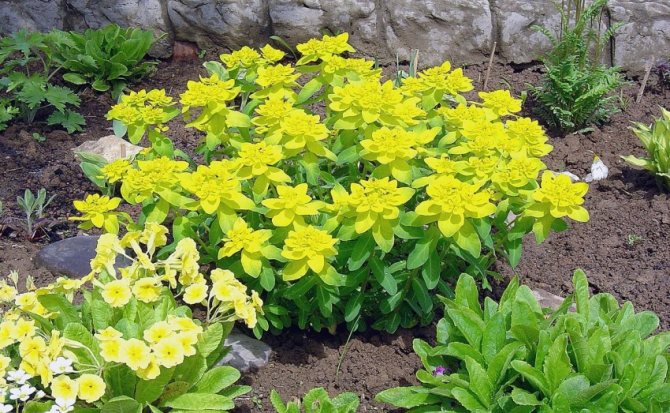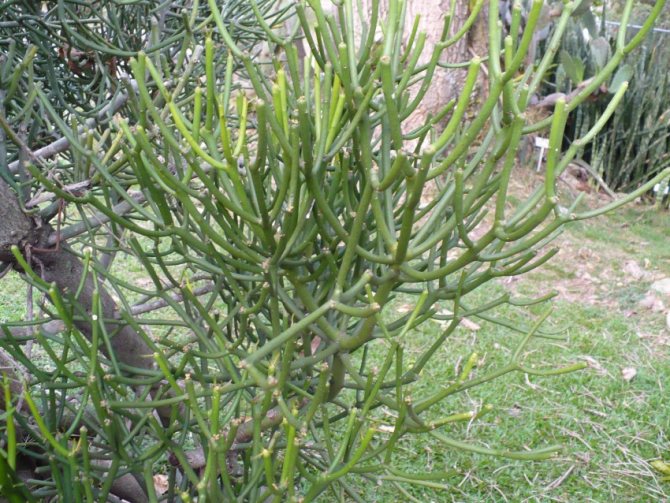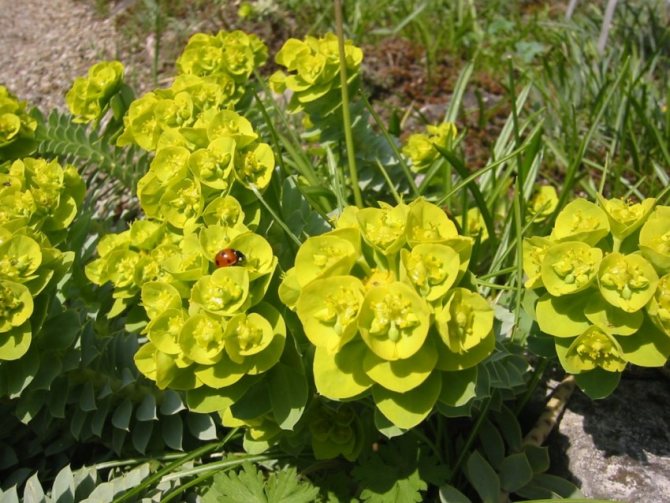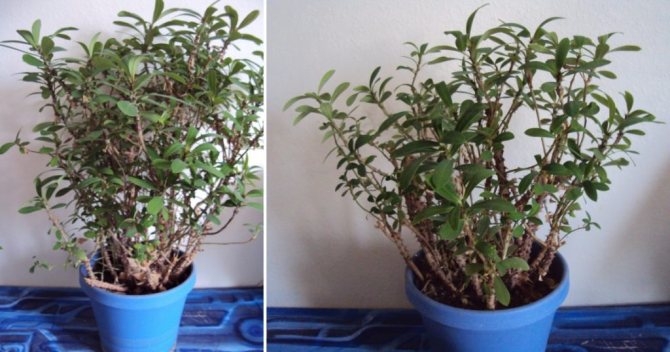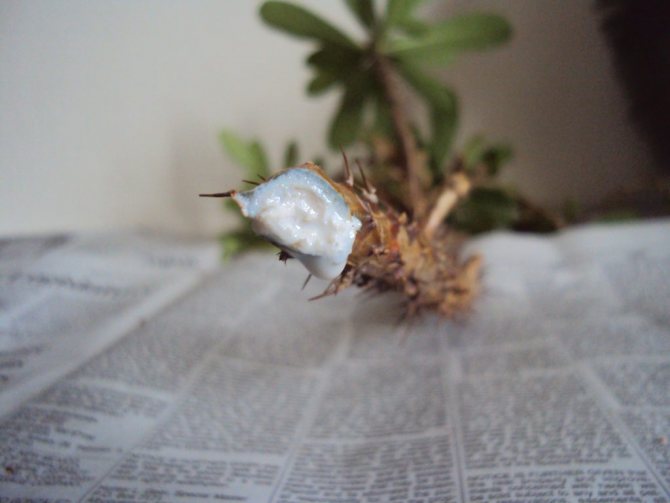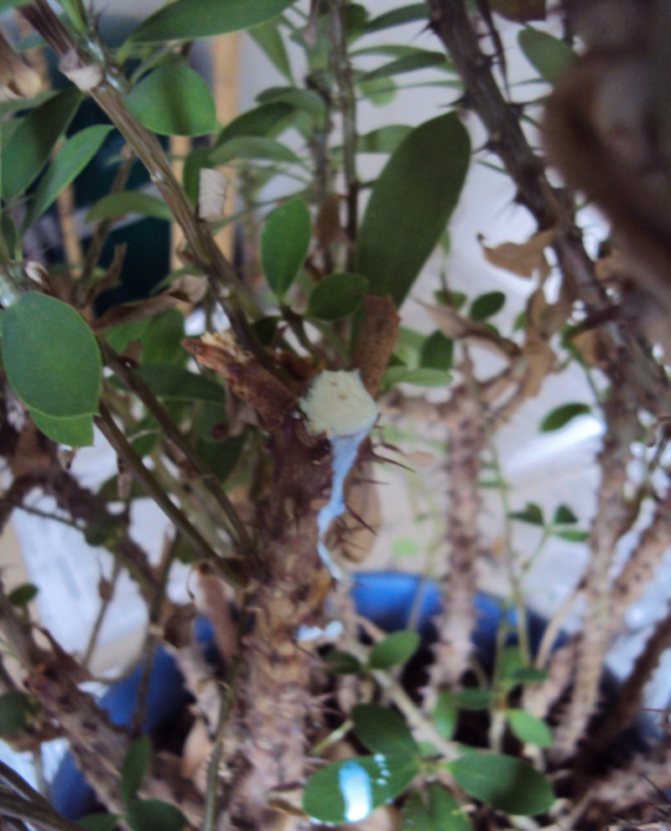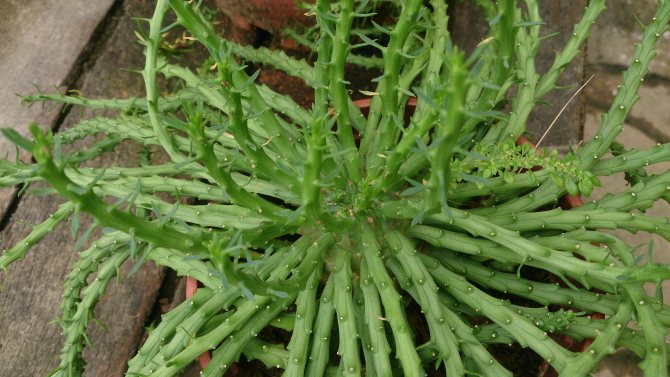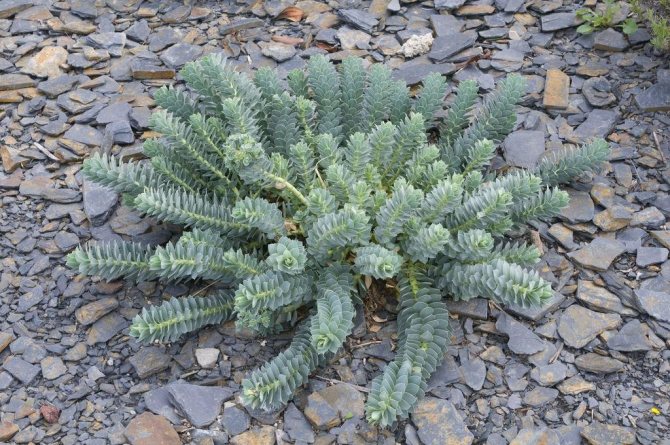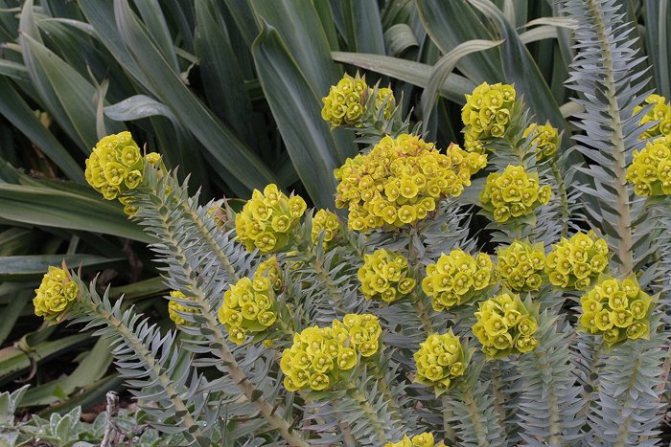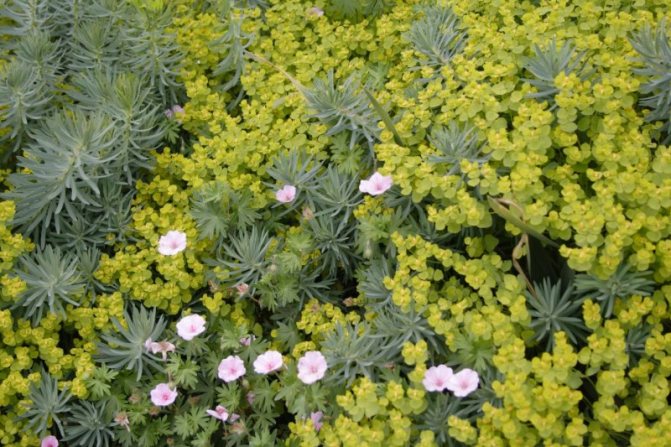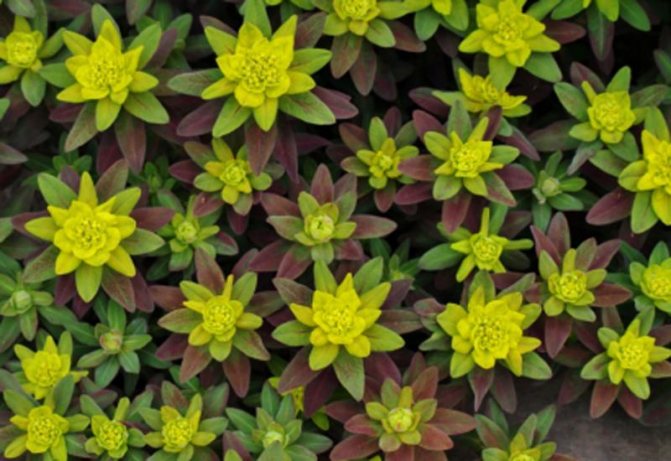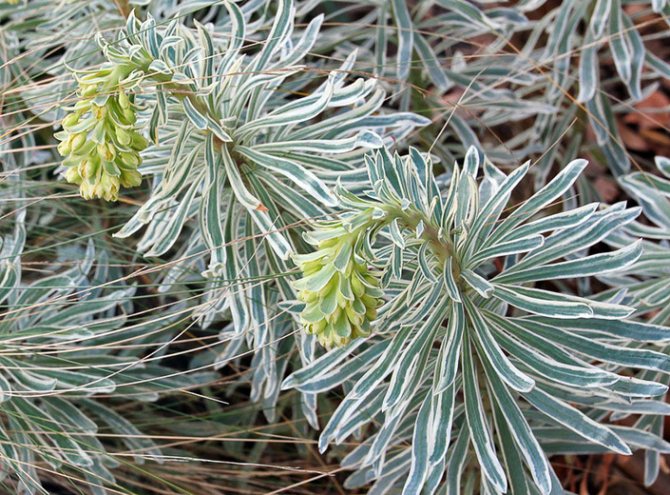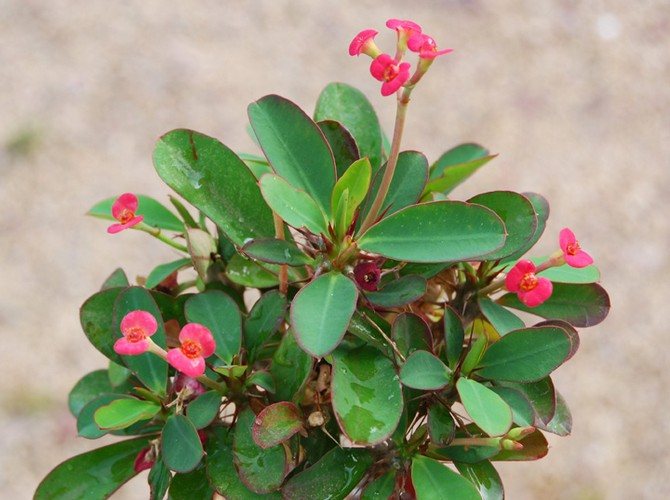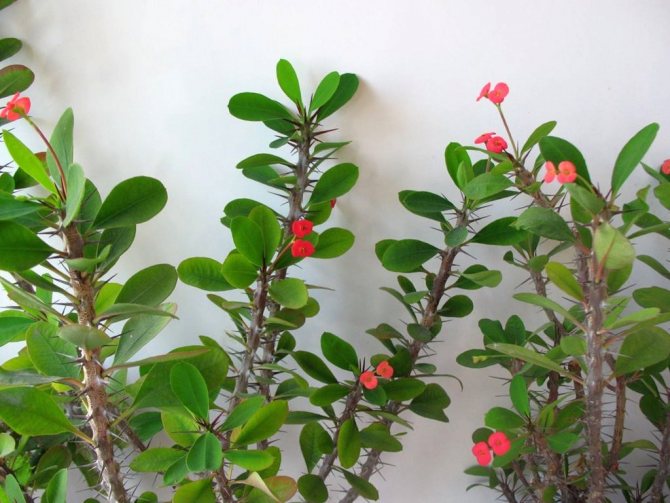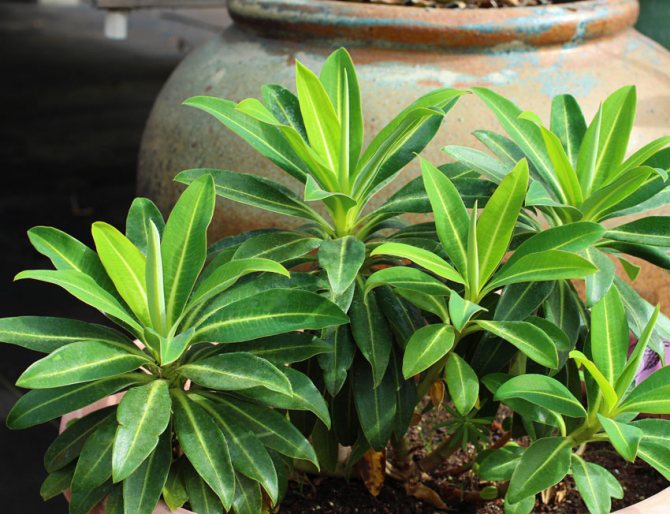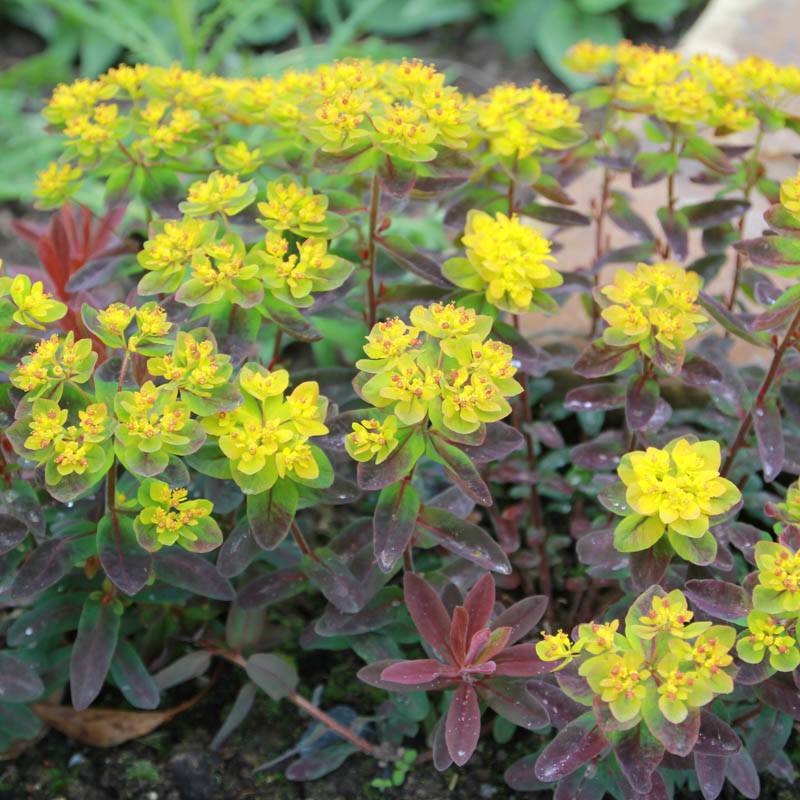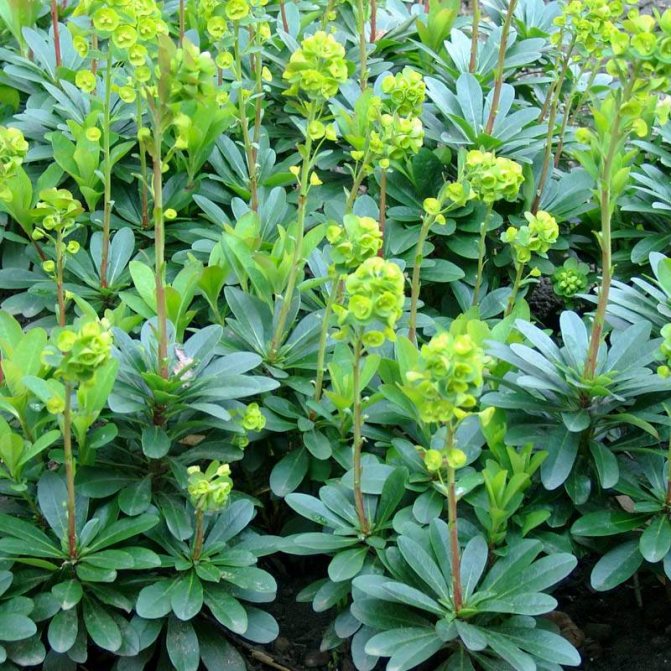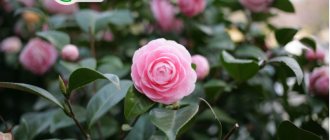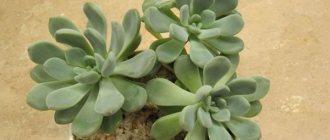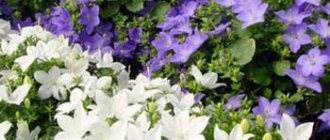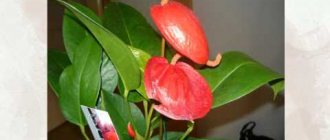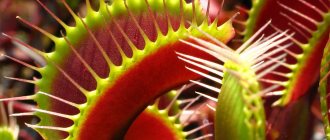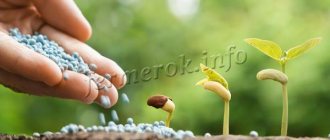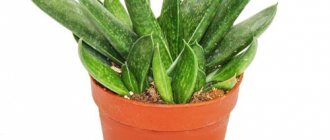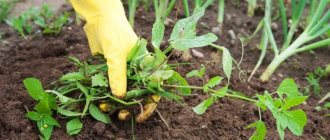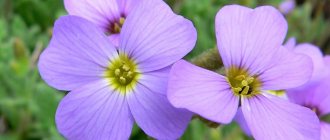Euphorbia (Euphorbia) is a perennial evergreen shrub of the Euphorbia family, depending on the species, tall (more than 1 meter in height), low (10-50 cm) or creeping (no more than 5 cm). Southeast Africa is considered to be the homeland of milkweed, in addition, it is common in the subtropics of Asia and America.
Indoor spurge is an unpretentious decorative flower, all types of which, in appearance, are completely different from each other. They can look like real trees or like cacti, or they can even have such a bizarre shape, which has no analogues in wildlife. The appearance of the inflorescences also depends on the type of plant, the flowers can be bright and interesting or completely inconspicuous and inconspicuous.
Be sure to read about the mile in detail.
| Globular forms grow slowly, and tree-like ones grow quickly, up to 30 cm per year. |
| Flowering occurs in different ways. There are a lot of plant species. |
| The plant is easy to grow. |
| It is a perennial plant. |
White-fronted (Euphorbia leuconeura)
This plant, popular in the culture of indoor flowers, is named for white veins on a lush green background of leaves and on the edges of the trunk. The white color is due to the concentration of milky juice. A young plant is a lush rosette of large bright green leaves, wide and rounded at the edge, dense to the touch, with a glossy surface.
Euphorbia, like cactus, sansevieria, hibiscus, spathiphyllum, zamioculcas, Christmas tree, chlorophytum, tradescantia, are classified as unpretentious indoor plants. They are able to create home comfort without much maintenance costs.
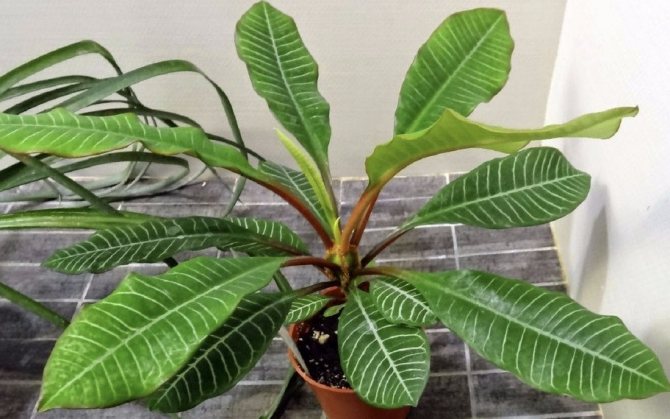
An adult plant, as it grows, forms a thick pentahedral trunk, which lignifies at the base, and at a venerable age it can branch out, forming bizarre shapes, for example, a figured candelabrum. During the flowering period, nondescript peduncles appear in the leaf axils, inconspicuous white small flowers, more like sprouted bulbs. The flower buds contain seeds that can shoot up to four meters from the plant. Euphorbia white-veined does not require special care and attention at home, however, there are several rules:
- watering - as the soil dries, not more often; spraying is necessary in a hot period;
- lighting - saturated, but not in direct sunlight;
- temperature - room temperature, 18–23 ° С;
- air humidity is moderate;
- the container is wide rather than deep;
- unpretentious to the composition of the soil, transplanting young specimens - annually; adults over five years old - every two years.
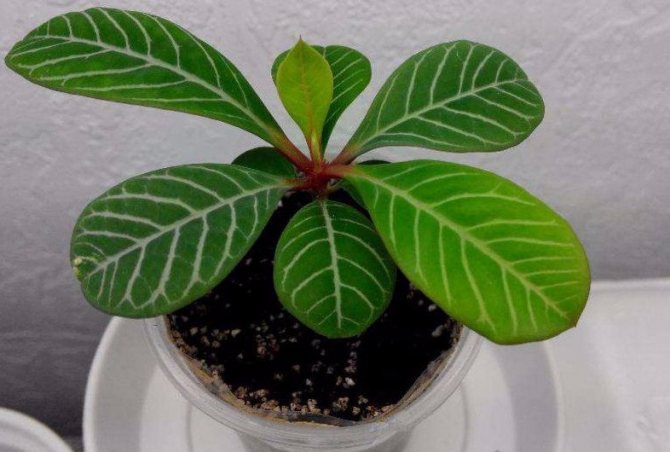

Important! The milky sap of the plant is poisonous; when working with it, it is advisable to protect the skin and mucous membranes of the eyes in order to avoid severe burns.
Features of growing at home. Briefly
| Temperature regime | The temperature in summer should be 19-24 ° C, in winter, a decrease to 15 ° C is permissible. |
| Air humidity | Moderate or decreased. |
| Lighting | Intense, all but variegated species prefer direct sunlight. |
| Watering | During the active growing season - once a week, during rest - 1-2 times a month .. |
| Priming | Industrial production marked "for succulents" or homemade from turf, humus peat and sand in equal proportions. |
| Top dressing and fertilization | In the spring-autumn period, monthly complex preparations for succulents. |
| Transfer | Annual, as the plant quickly "outgrows" the size of the proposed pot. |
| Reproduction | For most species, the grafting method is applicable, spherical propagated by seeds. |
| Growing features | Home spurge can stretch out in insufficient lighting, in which case it will be necessary to periodically carry out formative pruning of its crown to preserve the decorative effect of the bush. Mile can shed the leaves. If this happens, the shoots will have to be cut off, since the foliage of this species does not recover. |
Bluish (Euphorbia coerulescens)
Euphorbia bluish got its name from the bloom of wax on the green part. This type of euphorbia can reproduce vegetatively, therefore it grows rather quickly, occupying a large area. The trunk of the plant is thick, up to 50 mm in circumference, has from four to six faces with tuberous horny formations on the ribs.
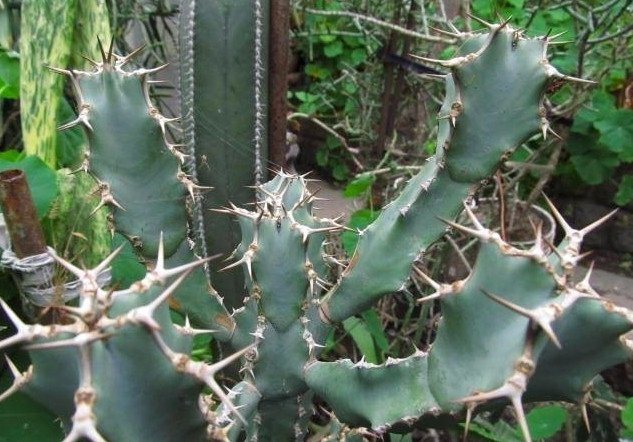

Instead of leaves, the succulent has a dark brown thorn in the form of horns, often also covered with a bloom. Strong volumetric spikes over a centimeter in length.
Succulents are plants that do not require frequent watering. In addition to milkweed, succulent plants also include aichrizon, echeveria, agave, aloe, echinocactus, nolina, stapelia, kalanchoe, and fat woman.
This species prefers partial shade and moderate watering; it can be fertilized only in summer. During the rest period, he needs coolness, but not lower than +12 ℃, watering for this period stops.
Milkweed properties - harm and benefit
The hardened milky juice of the euphorbium milkweed is characterized by a wide range of healing effects: in medicine, it is used to create laxatives and emetics for parasitic invasions and various kinds of poisoning. Healers and alternative medicine specialists attribute anti-cancer properties to Euphorbium. The Hindus treated snakebites with crushed milkweed root mixed with pepper.
In our latitudes, with the help of milkweed, they got rid of corns and warts, spots on the face, freckles and lichens, used milkweed to remove spoilage and even treated hydrophobia. In the Siberian regions of Russia, in Altai, milkweed was used to cleanse the blood and cure intestinal and kidney diseases.
- Pelargonium royal
Despite the huge variety of milkweed species, almost all of them contain rubber, resin, amorphous copper, gum, mineral salts, coumarins, flavonoids, alkaloids and other valuable substances in their juice. Unfortunately, scientists have not yet studied the thoroughly beneficial properties of milkweed.
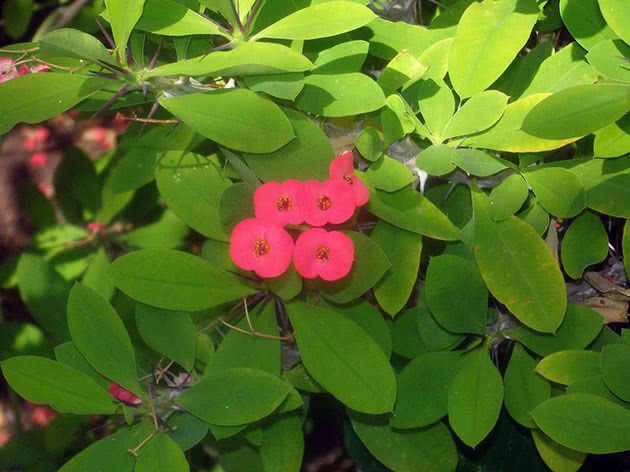

On the other hand, milkweed juice, if handled carelessly with the plant, can cause serious burns, wounds, severe itching and irritation of the skin, and in severe cases threatens with loss of vision and the formation of severe ulcers on the skin. Therefore, before growing the milkweed at home, learn the safety rules: wear gloves when you are going to care for the milkweed and keep this flower away from children and pets.
Melon (Euphorbia meloformus)
Melon euphorbia has a rounded shape, up to 10 cm in height, grows in width from 5 to 10 cm.As it grows older, it grows overgrown with numerous children closer to the base. The rounded thick stem process has a triangular facet shape - from eight to twelve.
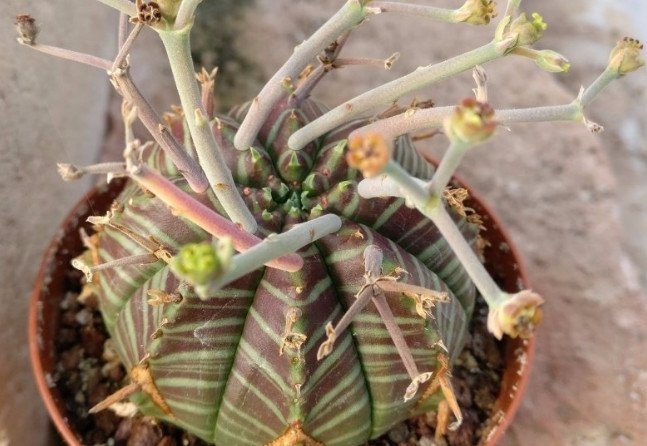

The color can be gray-green, marsh color, light green and bluish tint. The ribs are covered with raised, lumpy formations, and the edges are often decorated with transverse stripes of brown, dark green, or gray. In the upper part (mainly in females), solid peduncles are formed with small green-yellow or reddish flowers.
Indoor melon euphorbia loves moderate humidity, loose, light and nutritious soil with mandatory drainage.
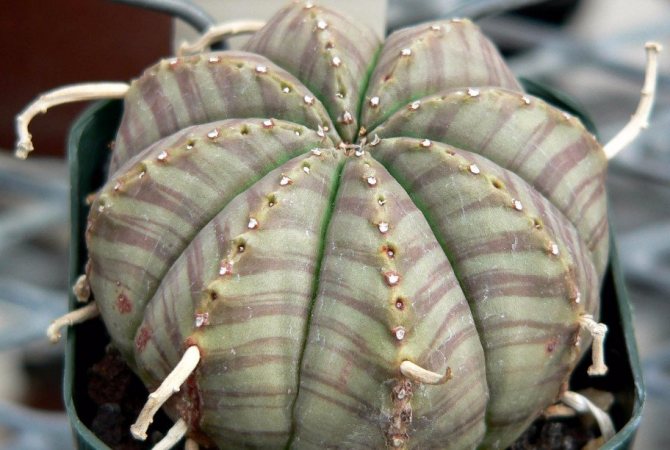

Important! In winter, the plant is not watered; in rare exceptions, the soil lump is slightly sprayed.
Temperature regime
The optimum temperature for active growth is + 18- + 22 ° С. In the summer months, you can take the flower out into the fresh air, shading it during the hours of especially bright sun. Temperature changes are not particularly dangerous, but the plant does not like drafts - it is important to take care of their absence when choosing a place to place a flower.
During rest, the plant is transferred to a cool room with an air temperature of about + 15 ° C. Under these conditions, the plant will be able to prepare for the next flowering.
Spraying
There is no need for additional air humidification, it may even be contraindicated for plants, since moisture that gets on the leaves and stems often provokes their decay.
To increase humidity in the winter months, spraying can be replaced by placing pots in pallets with wet expanded clay. Plants at this time are removed away from heating appliances.
Lighting
Milkweed needs a lot of light, only under this condition will it bloom and look as decorative as possible. The plant pot is placed on the south or southeast windows.
With the onset of cold weather, additional lighting can be organized - this will help prolong the period of its active growth and flowering.
Watering
Succulents are able to store moisture in the leaves and stems, so they do not need frequent soil moisture.
The watering mode is as follows: in summer - once a week, and the soil should have time to dry out between waterings, in autumn and spring watering is reduced to 1 time in 2 weeks, and in winter it is watered even less often - once a month.
Pot
The container for planting is chosen taking into account the size of the plant: its root system should have enough room for development, but the pot should not be too spacious. Large plants need heavy and stable pots to keep the plants from falling off their own weight.
Good aeration of the roots is also important for flowers, therefore, planting them in containers without drainage holes is strongly discouraged.
Priming
For cultivation, any industrial soil offered by flower shops marked "for succulents" is suitable. You can also prepare the soil mixture for the plant yourself: it is made up of equal shares of sod land, peat, humus and sand.
Top dressing and fertilization
Caring for milkweed in an apartment provides for regular feeding of the plant during its active growing season. Fertilizers are selected suitable in composition for cacti and other succulents, they are applied from spring to autumn at intervals of every 2 weeks. For the winter, feeding is canceled.
You should not feed with nitrogen fertilizers, as they provoke almost uncontrolled growth of plant stems, which can lead to their damage.
Milkweed transplant
Young bushes need to be transplanted annually, as they grow out of their pots very quickly.
Adult plants can be transplanted less often - once every 2-3 years, old bushes, which have already reached their maximum size for themselves, can not be touched at all, only renewing the top layer of soil in pots from time to time.
Pruning
It only makes sense to prune if it forms lush bushes as it grows. Carrying out the procedure, it is enough to remove dry branches from the plant and thin out the young growth, this will greatly facilitate the further growth of the flower.
Some varieties (such as triangular euphorbia) do not need pruning at all; they shed dead shoots and dried leaves themselves.
And in Mil's milkweed, for example, only the apical shoots are cut off in order to give the crown a neat and lush appearance.
Dormant period
Like many other plants, it rests in winter. At this time, the plant must provide the correct temperature and watering regime.
The plant will usefully and comfortably spend a dormant period if the room temperature is + 10- + 15 ° C, and watering will be carried out as the soil dries up no more than 1-2 times a month.
Is it possible to leave euphorbia without care for the duration of the vacation?
The plant is one of those surprisingly unpretentious plants that are able to wait for their owners, who are absent for various reasons, without any care for a whole month. Before leaving, it is enough just to water it abundantly and move it away from the window, and then nothing will happen to it for a long time.
Bold or obese (Euphorbia obesa)
There is some similarity of this species with the variety described above: the thick trunk has a rounded shape, it is also small - up to 12 cm high and 8 cm in circumference. The trunk is also divided into segments, though not so pronounced and with slightly convex ribs. The difference lies in the absence of thorns on the plant. The color of the obese euphorbia is gray-green or dark green, with dark stripes. Single inflorescences, collected in a bunch at the top of the trunk. Obese spurge loves deep pots, moderate watering as the soil dries. In winter, the plant is dormant.
Diseases and pests
- Lower leaves milkweed fall offif the irrigation regime is violated or the plant is in a place too cool for it. Another reason is the lack of phosphorus. To solve the problem, you need to adjust the watering and air temperature to optimal, as well as feed the flower.
- The stem rots - the reason most likely lies in excessive watering and too low air temperature. The solution is to organize optimal growing conditions.
- Spurge does not bloom in case of insufficient lighting, the plant must be transferred to the brightest part of the house so that it can receive the right amount of sunlight.
- Leaves wither - the flower does not have enough moisture, it needs to optimize the watering regime.
- Brown or black spots on the leaves - most likely the plant is affected by a fungal disease, it must be treated with a suitable fungicidal preparation.
- Yellowing of the ends of the leaves milkweed indicates overdrying of the earthen clod, or the excess of calcium in the soil. The plant needs to be watered abundantly and the feeding should be temporarily suspended.
- The emergence of the cobweb - a spider mite appeared on the plant. You can remove it at the initial stage of infection with a warm soapy-water solution, if the pest has spread over the flower strongly, you will have to use insecticidal preparations.
- Leaves milkweed warp, dry and fall off - it is possible that the flower is affected by a mealybug, they get rid of it with the help of the same soap-water solution and insecticides.
In addition to these insects, scale insects, aphids and thrips can also attack. Special preparations against pests of indoor plants help to destroy them.
Canary (Euphorbia canariensis)
Under natural conditions, the abundant branching shrub reaches three to four meters in height; at home, of course, much less. This succulent has a fleshy trunk of four or five faces, with well-defined ribs, without foliage. The ribs are protected by two-spiked spines growing from kidney-like formations half a centimeter long.
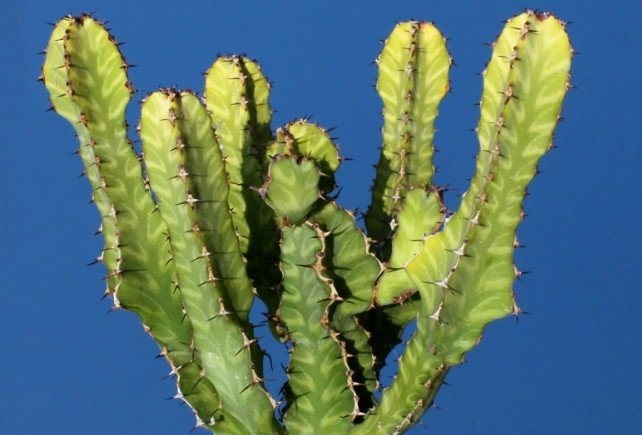

It needs pruning, sanitary and formative. Every year, you should trim the top and remove weaker or abnormally growing processes - thereby you will give it a beautiful shape and heal, rejuvenate the bush.
Propagation of euphorbia by cuttings
Reproduction of milkweed euphorbia cuttings photo
Euphorbia can be propagated by leaves or shoots. The best time for cuttings is autumn.
Algorithm of actions for reproduction using an escape:
- a process is isolated, the length of which from the leaf node to the end is approximately 10 cm and cut off;
- get rid of the lower leaves;
- the juice that stands out on the cut must be washed off with water.
- the cut itself is dried with a dry towel and, with the help of charcoal, the "wounds" are powdered;
- the stalk is dried for 1-2 days until a thin dry crust is formed, so that the stalk does not rot during planting.
- plant it in prepared sand, which is pre-moistened.
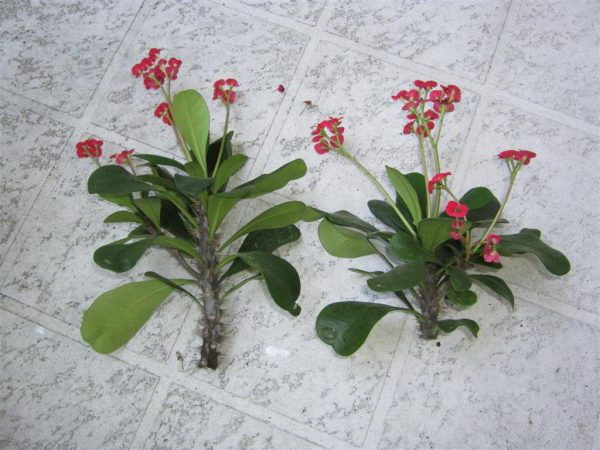

Cutting euphorbia for reproduction photo
To make rooting without problems, the planted stalk is covered with a matte cap. The sand is periodically moistened. A shoot requiring rooting is not placed in direct sunlight.
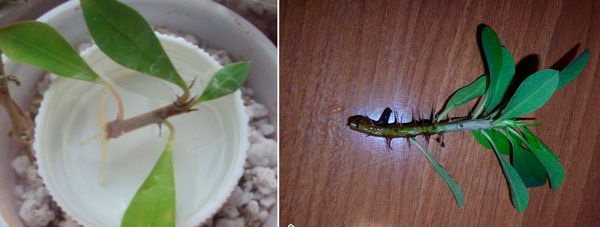

Milkweed cuttings Mil photo
If leaves are used for propagation, then protective gloves should be worn. We do the following:
- first, the leaf is pinched off along with the handle;
- the released milky juice is washed off, the cut is dried, then the leaf is placed in a solution of a growth stimulator;
- planting is carried out in soil well-saturated with water;
- it is not worth covering with a film, so as not to provoke rotting and death of the cutting.
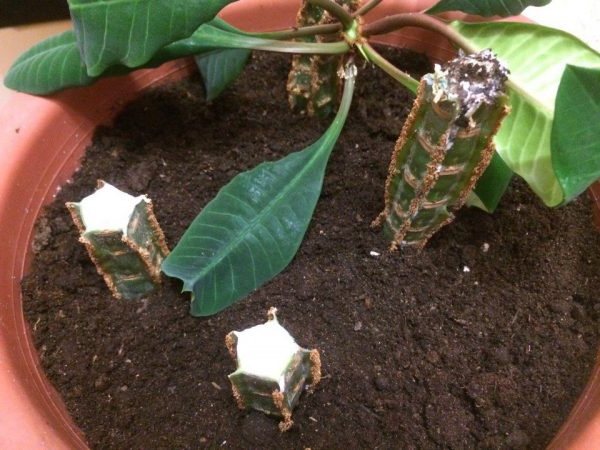

Euphorbia reproduction by cuttings photo
Cypress (Euphorbia cyparissias)
Cypress spurge is a herbaceous plant that resembles a juniper. It grows strongly in natural conditions and takes the form of a neat small bush. In indoor conditions, its height does not exceed half a meter. It has straight stems, densely covered with needle-like, bright green leaves. During the flowering period, dense bundles of inflorescences are formed on the tops of the stems. Small flowers on long pedicels are surrounded by bright reddish or golden stipules.
This species is drought tolerant and tolerates underfilling better than overflowing. For a lush, bright flowering, he needs bright lighting for at least ten hours a day. The plant is fed once a year with a liquid complex mineral composition.
What can harm
Most often, diseases occur due to improper care.
- The flower began to rot - most likely it is standing in a draft;
- The appearance of mold and leaf fall is a sign of a lack of moisture.
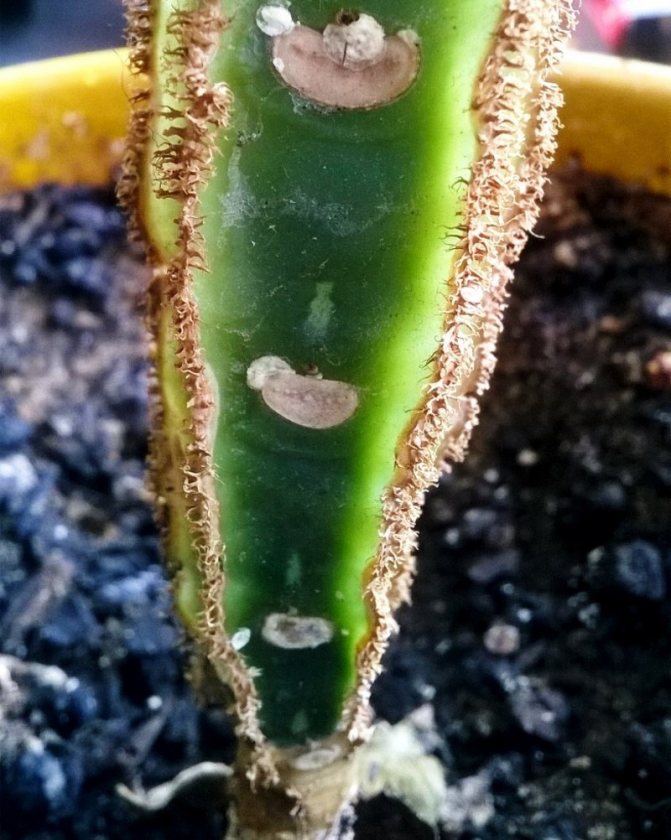

Pests also often attack it: root or mealy worm, aphid, spider mite. All of them can be the reason for the yellowing of the leaves. To solve this problem, it is enough to purchase a special pest control product in a gardening store.
Large-root (Euphorbia clavigera)
This species is called large-rooted because of a modified trunk, similar to a swollen root shoot protruding from the soil. Curved light green processes, divided into sections, provided with long double-spiked spines along the edge of sharp ribs, grow from a lignified, irregularly shaped thickening. At the tops of the shoots, in the grooves between the thorns, there are sessile buds-inflorescences. Yellow cup-shaped flowers with three or four long stamens break through from the buds. This plant is most commonly grown as a bonsai. He needs bright lighting, the temperature is from 22 to 26 ° C, otherwise the care is the same as for the rest of the succulents.
Did you know? The name of the milkweed "euphorbia" is mentioned in the writings of Pliny. In his "Natural History" he describes the case of a miraculous recovery from a serious illness of the ruler of Numibia. To immortalize the name of the doctor who saved him, Euphorbos, King Juba named the plant from which the doctor prepared the saving medicine.
Reproduction
Propagation of milkweed by cuttings
The usual and easiest way of propagation for most euphorbia is by cuttings. Planting material is obtained from adult plants by cutting off the tops of the stems about 12-15 cm long.
The cuttings are left to wither for a couple of days, after which they are planted in the sand until good roots appear. Rooted young plants are transplanted into suitable pots, then they are cared for as usual
Propagation of milkweed by seeds
This method is relevant for spherical varieties. Fresh seeds are sown in a mixture of leafy earth and sand. It is possible to accelerate the ripening of seeds and the emergence of seedlings by maintaining the temperature in the room + 18 ° C.
The pick is carried out in the phase of the appearance of the first shoots, then the seedlings are looked after in the same way as for adult plants.
Bighorn (Euphorbia grandicornis)
The large-horned milkweed has a three-ribbed trunk with edges concave inward. It is divided into segments of irregular shape, each upper segment is a continuation of the lower one. On the uneven edges of the ribs, two spines looking in different directions grow from one tubercle. In the natural environment, the spurge blooms with bright yellow dense flowers, in room conditions it practically does not bloom.
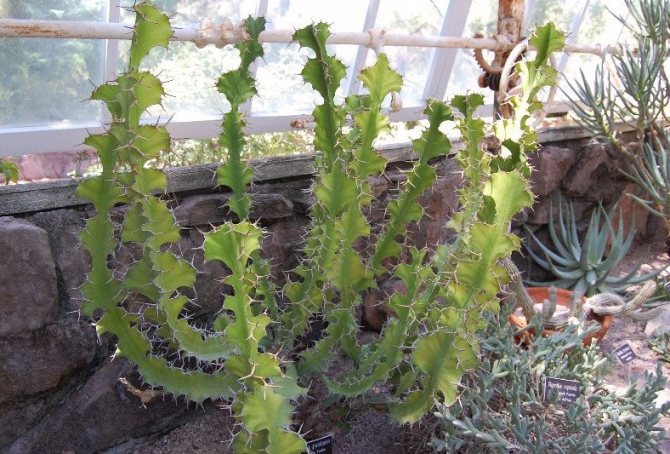

Under good conditions - bright sunlight, moderate watering and room temperature - the plant can grow to the ceiling.
Danger of milkweed
Euphorbia is considered poisonous, therefore it must be used very carefully. If children are in the house, then the plant must be kept as far from them as possible - it can cause damage to health.
What is the risk? All modifications of room milkweed can produce milky juice, which is extremely dangerous and poisonous. This juice is located in the first lines of all poisons that plant crops emit. It is dangerous for both children and adults, as well as for pets and people with allergies.
Burn of the skin cover. The defeat of the skin cover by the poisonous milky juice can provoke inflammation and severe burns. Probably the appearance of an allergic reaction, as well as rashes. If the juice hits the skin, then rinse the burned area thoroughly with water and apply ice. Antiallergic (antihistamine) medication is also recommended.
Eye contact. Penetration of juice into the eyes is quite dangerous with permanent or temporary blindness. If this happens, then you need to consult a doctor immediately. You need to rinse your eyes before going to a specialist, and also drip antiallergic drops. For what it is allowed to use "Cromhexal". These drops are especially effective for redness. It will be useful to drip "Albucid" in order to prevent infection. You can also anoint your eyelids with erythromycin ointment. In any case, you need to be very careful with the plant.
Ingestion or ingestion. In these situations, milky juice is quite unsafe. Such manifestations are possible:
- Vomiting, as well as nausea;
- Dizziness;
- Decrease in body temperature;
- Fainting conditions;
- Breathing disorder;
- Swelling of the tongue;
- The development of seizures.
During the early symptoms of poisoning, you must immediately call a doctor.
Before the arrival of a specialist, it is recommended:
- If vomiting occurs, then you should swallow pieces of ice;
- Take activated charcoal. It can be diluted in sodium bicarbonate for good bowel lavage;
- Make an enema;
- Inside, take laxatives based on magnesium or sodium;
- If an allergy is noted, then an antihistamine medicine should be used.
Mile (Euphorbia milii)
Euphorbia Milia (Miliusa) is a thorny shrub that, in addition to thorns, also has foliage. On a ribbed gray trunk, closer to the apex, juicy green teardrop-shaped leaves grow: narrow at the petiole, they smoothly expand, rounded along the edge. The surface of the leaf plates is smooth and shiny. When blooming, Mila spurge produces long peduncles, usually with two flowers of pink, white or yellow color. The flowering period of the plant begins when it reaches 25 cm in height.
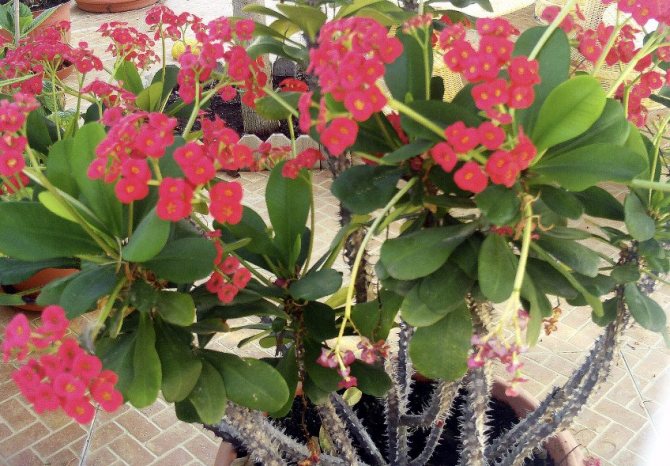

In the spring-summer period, the plant needs moderate watering and feeding, it is imperative to remove dried flower stalks and leaves. During the rest period, the temperature should be at least 12 ° C.
Main types
Euphorbia beautiful (Euphorbia pulcherrima)


It is also called poinsettia. This is one of the most popular home-grown milkweed. The flowering of this plant falls on Christmas (Catholic).However, it is not small flowers that betray a spectacular appearance to the plant, but bright leaves growing under the inflorescences. Depending on the variety, these leaves can be pink, deep red, or white. If the room is too warm and the air humidity is too low, then with the end of flowering, all the leaves of the plant fall off. This species is quite picky about care.
Euphorbia resinifera


This plant is cactus-like and has tetrahedral green-gray shoots. On the ribs there are warty protrusions on which there are thorns. This is a very non-capricious plant.
Euphorbia hypericifolia (Euphorbia hypericifolia)


Which is also called "Diamond Frost" - this non-capricious plant is very loved by flower growers. He is usually planted in hanging baskets. On a hat of pale green leaves, there are many small white flowers that are very similar to snow-white foam.
Mille spurge (Euphorbia milii)
Such a not very large thorny bush is also called a "crown of thorns". On its gray, powerful shoots, oblong leaves are located. The young shrub is very beautiful, as there are many small flowers on it, which have bracts of a rich red or pale yellow color, which contrast with the dark green foliage. The old plant becomes similar to a prickly dry shrub. Feels great near the window located in the southern part of the room.
Puffy or obese spurge (Euphorbia obesa)
This succulent plant is very similar to a cactus. It has a stem in the shape of a ball, on which there are subtle ribs. It has no leaves or thorns.
Large-horned spurge (Euphorbia grandicornis)
It has a rather bizarre shape. Its fleshy branching stems are triangular. On the edges there are large gray or brownish-yellow spines. Leaves grow on young shoots and fly around pretty soon.
Triangular spurge (Euphorbia trigona)
This rather showy tall plant has triangular branching stems. Leaves, which have an oblong shape, grow at the ends of young stems. After a while, the leaves fall off.
Euphorbia tirucalli (Euphorbia tirucalli)
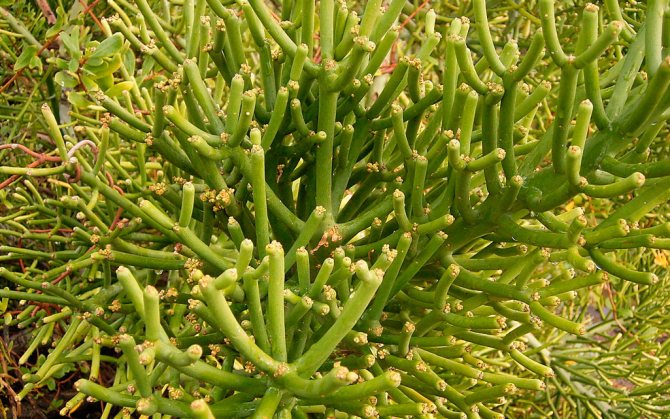

Such a succulent plant is undemanding to care for. The shoots of this very bushy milkweed are similar to small green sticks. It lacks both thorns and leaves.
Milk (Euphorbia lactea)
The milky white spurge grows as a shrub, the white ribbed trunk branches out as it grows and is densely overgrown with lateral shoots. The ribs of the shoots are literally dotted with triangular tubercles, which end in thorns.
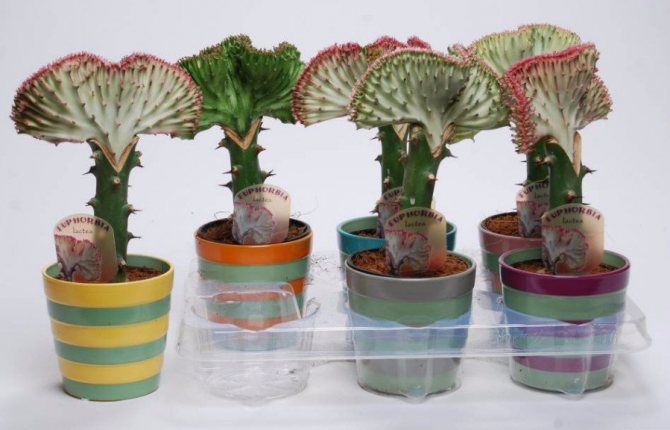

There is a very interesting in room culture form "Cristata": from a thick trunk, divided into three or four sides, it blooms in the form of an open, wavy fan along the edge, a milky-colored formation, often with a pink border along the edge.
The main signs of milkweed
All types of milkweed produce milky juice.
As noted earlier, it is not possible to give an exact definition of the euphorbia family due to the absolute dissimilarity of its representatives. Some species have large oblong leaves, while others have small leaves with a lot of thorns. Most varieties have a strong, erect stem, and some do not have one at all. There are types of milkweed that are difficult to distinguish from a cactus, because instead of leaves, they are strewn with many needles. As for flowering, in this matter it still depends on the selected species. Most of the representatives of this family have small buds or do not bloom at all, but there are also densely blooming milkweeds, which will delight you with beautiful spike-shaped inflorescences.
Multifaceted (Euphorbia polygona)
The multifaceted euphorbia is so named for a reason: its trunk sometimes has up to twenty sharp edges.The bush can be with one spherical stem, similar in appearance to a cactus, or it can consist of several cylindrical stems. On the edge of the ribs there are brown bud tubercles and sharp spines. Dense flower buds are located on long peduncles.
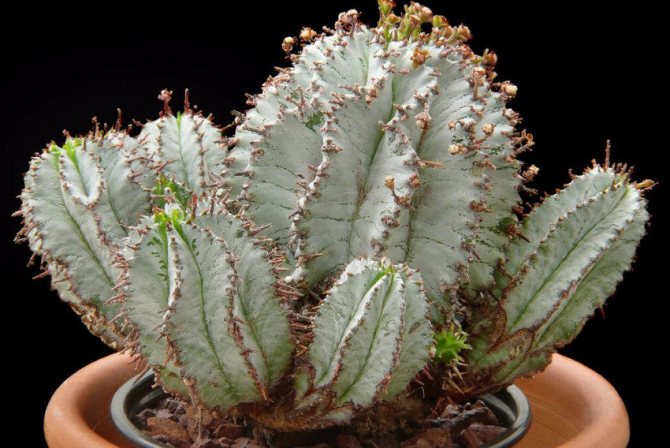

This species prefers to develop in partial shade. It is better not to water during the rest period.
How to propagate homemade spurge
Among the breeding methods, there are 3 main ones:
- seminal;
- using cuttings;
- division of the bush.
Which one is the most effective? Concerning the plants of the spurge family, this opinion is ambiguous. Each type requires an individual approach. The most accessible and simplest is the vegetative method. For species that cannot be propagated using cuttings, and these are primarily spherical species, the seed propagation method is used. If you take a plant such as garden spurge, then it continues its genus with the help of root processes.
Triangular (Euphorbia trigona)
A fast-growing species, in indoor conditions it grows up to a meter in three years; due to the branching of the plant, a slender compact bush is formed. But as it grows, it will need support, since the root system is superficial and, due to its own weight, the bush can break or fall out of the pot.
The edges of the trunk are concave, glossy, with a bright light green color. On sharp edges, instead of thorns, teardrop-shaped leaves grow with a convex sharp tip and a central stripe along the leaf. Partial shade or diffused light - the plant develops equally well there and there. It responds well to liquid mineral supplements.
2.Growing in the open field
Planting spurge in open ground should be carefully - over time, some of its varieties easily multiply and fill all free spaces in the garden. It will not be easy to get rid of such plants, because euphorbia often recovers from even a small piece left in the ground after weeding.
For cultivation in the garden, such varieties are used as euphorbia bordered, m. Capitate, m. Multi-flowered, m. Almond-shaped and m. Cypress.
Winter well in conditions Middle lane also m. long-leaved, m. swamp, m. coastal, m. long-horned, m. Altai and m. rocky.
↑ Up,
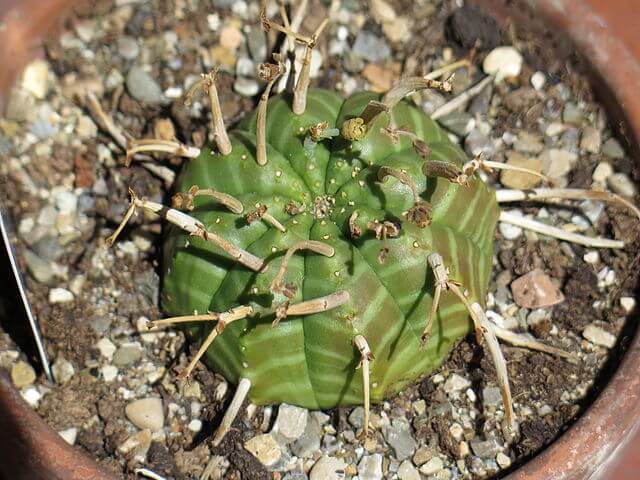

For cultivation, a plot of land open to the sun is selected. You should not plant euphorbia in flooded lowlands - the bushes will rot if there is excess moisture in the soil.
Depending on the planting scheme and plant height, they prepare landing holes, the depth and width of which exceed the root ball by about 1.5 - 2 times.
A drainage layer in the form of broken bricks or river pebbles is placed at the bottom of the holes. Next, put a nutrient layer with a high organic content in the form of humus, well-rotted cow or horse manure.
↑ Up,


Plants are moved using transshipmentkeeping the earthen ball at the base of the flower intact. After planting, the substrate around the bushes is lightly tamped, and then watered with warm water.
The bases of the plants can be sprinkled a small layer of mulch - cut grass, straw or rotted sawdust. Mulch will delay the development of weeds.
↑ Up,
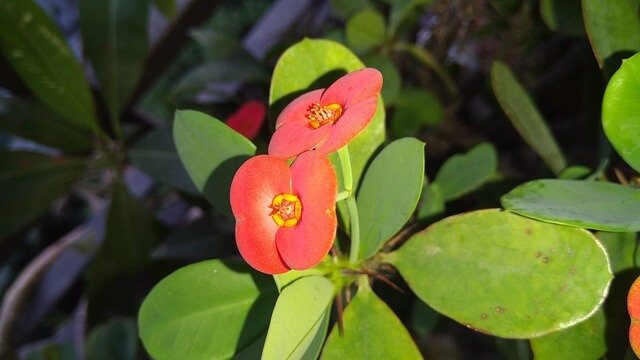

Further care for the planted milkweed will consist in timely weeding, loosening of the soil and top dressing.
IN watering established plants will rarely be needed - only when dry and hot weather has been standing for a long period of time.
Feed bushes with mineral fertilizers 2 - 3 times per season... Young plants will need nitrogen fertilization, and flowering plants will prefer fertilizers rich in potassium and phosphorus.
↑ Up,
Large plants grown outdoors will be need shelter... Among such varieties, spurge myrtle, m. Fiery, m. Mediterranean.
In the middle of autumn, when frosts are not rare at night, bushes spud, sprinkling the soil to the root system and cover up dry top fallen leaves and spruce branches.
Herbaceous euphorbia usually does not cover - their entire ground part may die off with the onset of winter, but in the spring the first shoots will reappear from the root.
↑ Up,
Cereus (Euphorbia cereiformis)
Euphorbia cereus is a large, well-branched bush with several multifaceted trunks. Gray-green stems along the edges of the ribs are decorated with large spines up to 2 cm in length, the spines are dense and voluminous. Leaves grow here and there, but they are so small and weak that they immediately dry up. Some of them immediately fly around, some last for a long time.
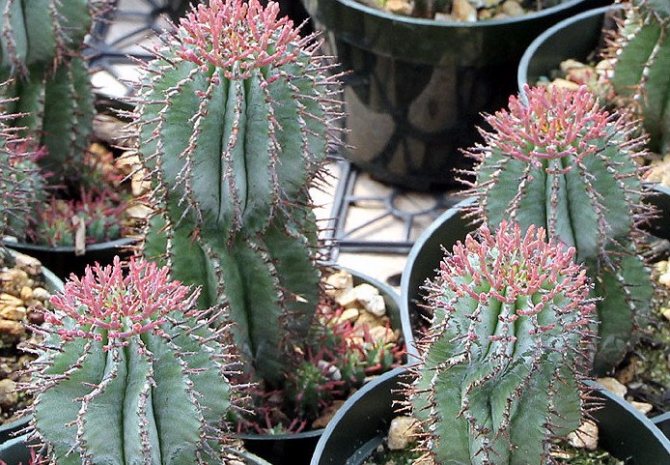

Direct sunlight is contraindicated for this type, sunburn spots will remain forever. The plant loves spraying, but watering should be done only as the soil dries on the surface.
How to properly prune milkweed
If pruning is carried out in order to rejuvenate the flower, then it is better to carry it out in the summer, as soon as the spurge has faded.
For this:
- dried stems are removed;
- if the shoots are strongly stretched, they are shortened;
- when pruning flowering crops, do not touch young shoots. It will bloom next year.
Not only the crown of the plant is pruned. When forming a dense, beautiful bush of milkweed, it is necessary to cut off absolutely all shoots at the end of winter. With such pruning this year, flowers cannot be expected, but after the season the plant will delight you with exuberant flowering, 2 times more abundant than before.
After pruning, the resulting cuttings can be rooted and many new plants can be obtained, more on that below.
Fisher or Pallas (Euphorbia fischeriana)
Pallas spurge, or the root man, as it is popularly called, really helps men cope with some sexual dysfunction. It is a herbaceous, undersized shrub, branched and leafy. It has thin flexible stems and neat triangular leaves, with an almost white stripe along, bright light green color. During the flowering period, small yellow flowers on long peduncles are formed on the stems, equipped with a pair of stipules. After wilting, a hazel fruit is formed. But the plant is famous for its root. The thick rhizome has several smaller processes, so that the whole mass looks like a human figure. When studying the composition of the root, substances were found that act depressingly on tumor cells.
Did you know? Esotericists suggest that the Pallas rhizome is the famous mandrake root. As you know, mandrake was used as an element of magical rituals and as a potent medicine.
How to prune spurge
Certain varieties of milkweed (multicolor, glittering, euphorbia Mila) require annual pruning. It is recommended to get rid of the leaves that have grown over the winter in June or July, after flowering. First, take a good look at the bush, and then remove the dried stems with garden shears. You do not need to cut off strong shoots, because they will delight you with bright colors in subsequent years. They can only be pruned if you want to turn your euphorbia into a very dense bush. Experienced flower growers recommend pruning shoots of renewal in early spring. Please note that after pruning, euphorbia will not bloom, and the result from the procedures performed will be visible only after a year.
Blooming milkweed should be trimmed with gloves, as its juice is acidic
Purchase and adaptation
When purchasing a perennial, pay attention to the condition of the stems: are there any foreign spots, damage, soft areas. The needles of a healthy plant are firmly attached to the ribs. The roots should not be dry and sticking out of the drainage holes.
- For the first two weeks, place the succulent plant separately from other flowers, looking closely for signs of pests and diseases.
- Transplant the spurge no earlier than a month after purchase.
- Provide Enople with comfortable conditions: good lighting, regular watering, temperature conditions.
- If possible, do not disturb the plant (do not cut and feed, do not move the pot often, etc.) - let it calmly adapt to its new place of residence.
Transfer
A plant purchased from a store must be transplanted if it is in a transport container. The flower will not be able to develop in the temporary container used to transport the plants.
An adult plant is transplanted as you grow. It is advisable to make a transplant in the spring... Many species of milkweed do not grow quickly, only extending a few centimeters throughout the year.
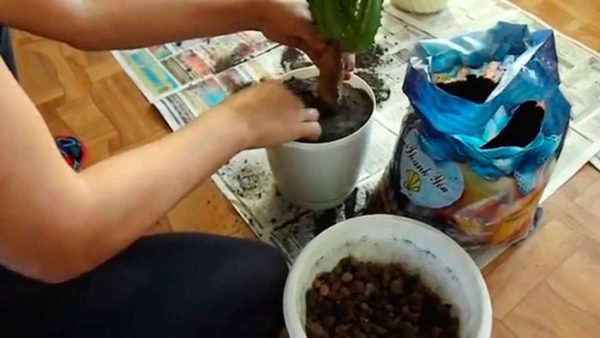

Milkweed transplant
Euphorbia do not do it plant in a pot that is too large, as excess soil can adversely affect plant growth.
Mr. Dachnik explains: is it possible to keep euphorbia at home
Euphorbia is endowed with life-giving power. It promotes family well-being, serves as a source of positive emotions. During flowering, the ability to bring good luck and happiness to the house is added to the positive properties. Euphorbia is considered a love herb that can get rid of the evil eye and damage.
According to existing signs, needle plants cannot be kept at home. Feng Shui experts believe that this flower is suitable for living quarters other than the bedroom. The best place for euphorbia is in the corridor. During the formation period, the plant is transferred to the living room.
Natural habitat
Favorable for such species of milkweed as marsh, steppe, pungent and weeds.
Spurge weed
It is a herbaceous annual. Its stem is quite juicy. It reaches a quarter of a meter in height. Flowering begins in early summer and ends in autumn. Bell-shaped inflorescences are colored in shades of red. It grows in European and Asian countries.
Swamp
This is a herbaceous perennial euphorbia, reaching a height of half a meter to a meter. Its stems are straight with an abundant number of oblong leaves. The inflorescences resemble an umbrella. Distributed mainly in semi-deserts and places with a temperate climate.
Euphorbia steppe
In the Russian Federation, steppe spurge can be seen on the banks of the Volga and Don, on the Caucasian slopes. In Ukraine, it grows in forest-steppe and steppe zones. Prefers limestone and chalk soils. It is a herbaceous perennial with an erect stem. Blooming lasts all summer.
Spurge spicy
Also from the category of herbaceous plants. It blooms with small yellowish flowers. Very tenacious and knows how to adapt to any kind of soil. Regenerated from the smallest root. It is extremely dangerous in that it sucks nutrients and moisture from the soil, depriving others of this advantage. It is difficult enough to eradicate it.
Below you can see the types of street milkweed in the photo:


Care errors and their elimination
Common problems in the cultivation of Euphorbia and their solutions:
| Problem | The reasons | Decision |
| Yellow leaves in summer | Stagnant moisture in the soil, draft | Water the plant in moderation, exclude the effects of drafts |
| Brown spots on shoots | Sunburn | Shade the spurge from the scorching sun |
| The stem is too stretched | Poor lighting | Move the flowerpot to a bright place |
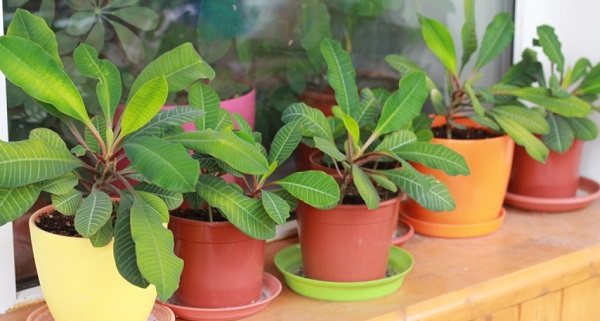

Appearance
It is quite difficult to answer the question of what the spurge looks like. And all due to the fact that there are 2000 species. So, one type of milkweed can look like a cactus, another looks like a miniature palm tree, and the third generally looks like a bush or ordinary grass. There are only a few traits that unite all this variety into one family.
- Stem. Very "fleshy", like all succulents (plants that store water in the stem).Structure, length, color - depend on the species. Often they have clearly defined edges and scars from fallen leaves.
- Inflorescence structure. Each new flower seems to grow out of the old one. A flower without petals, consists of one twisted pistillate flower. Around the remains of degenerate flowers - stamens, bracts. Blooms for a long time.
- Fetus. Ripens at the end of flowering. It looks like a triangular box with three seeds.
- Leaves. Usually dense, elongated, with reddish veins (but this is not a prerequisite).
- The presence of white milk when a leaf or stem is broken. This is the only thing that is necessarily present in any type of milkweed!
The use of milkweed
In Africa, some types of milkweed were used by aboriginal hunters to prepare poisoned arrowheads. Traditional healers use euphorbia for kidney ailments and as a laxative medicine, it relieves pain and is an antacid when bitten by a rabid animal.
The perfume industry uses it to add to whitening creams and lotions to help get rid of freckles. Some plant species are even used for food, after removing the existing thorns.
Since spurge is a natural aphrodisiac that increases human immunity, it is also an antibacterial agent. Therefore, with its help, wound healing occurs. Milkweed root can be used for headaches. The extract from the root has a strong emetic and is therefore used after a bite of wild animals or for gastric infections.
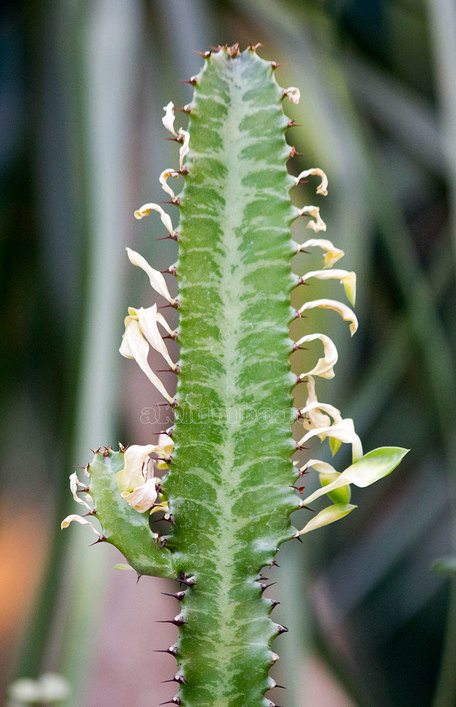

Decoctions can be used for taking baths for diseases such as:
- gout;
- teal;
- various skin rashes.
Also, with the help of undiluted milk, you can get rid of warts and lichen by lubricating the affected areas.
Tincture for healing fungal diseases
One teaspoon of herbs is brewed in 500 gr. a jar of boiling water. After 30 minutes of infusion, strain and apply this solution in the form of micro baths of the affected areas of the body.
Decoction for the treatment of the stomach
To cause a slight laxative effect, it is necessary to 5 gr. plant roots add half a liter of water and bring to a boil and turn off. Let it brew for 10 minutes and take a tablespoon three times a day.
Tincture for lichen
They take fresh plant juice and lubricate the affected areas with it. After 25 minutes, wash off with warm water.
But we must remember that treatment with a plant should be started only after consultation with the attending physician.
Contraindications
If there is an overdose of taking medications based on milkweed, then severe inflammation may appear on the skin, and if taken orally, this leads to severe poisoning of the human body. Therefore, it cannot be taken uncontrollably. It is not allowed to get pure milkweed juice on the cornea of the eye or an open wound.
During pregnancy and lactation, it is categorically impossible to use drugs that include euphorbia.
How to propagate spurge
The plant is usually propagated in 2 ways.
Planting seeds
The seeds are sown in October or March. A few hours before planting, they must be soaked in warm water. Next, plant the seeds in separate containers, making drainage holes there and pouring a nutritious soil mixture. Deepen them by 2-5 mm.
Then cover each pot with foil and put in a cool place. It is also necessary to regularly ventilate the soil and moisten it. The first shoots will hatch only after 2-3 weeks. Some species can reproduce by self-seeding.
Cuttings
In late spring or early summer, milkweed can be propagated by cuttings. They should be about 10-15 cm long. The lower leaves of the cutting are cut off, and the milky juice on the slices is washed off with warm water.
Treat these sections with powdered activated carbon and dry for 1 day. Plant the cutting in a prepared container with moist soil and a layer of drainage.
Euphorbia flower propagation methods
You can find milkweed seeds on sale. It makes sense to buy them and use them for sowing. Germination in most species is excellent, but only if fresh. Usually the germination rate is up to 99% in the first year, and in the second year it drops by 2-3 times. Much more often they are propagated by cuttings or by dividing a bush.
Cuttings
Eonium: home care and the main types of the family
Cuttings in ribbed milkweed are obtained by separating the shoots and cutting off the top. The separated part of the plant is left to dry until the milky sap ceases to stand out, and the cut is glued together with a rubbery substance. After that, the shoot or crown is immersed 1-2 cm into the prepared soil and covered with a transparent cap from a cut plastic bottle, glass jar or ordinary plastic bag.
It usually takes 2-4 weeks to root. It is not worth disturbing the process at this time, only the cap is opened once a day to ventilate. If the humidity in the room is above 60%, then you can freely do without a greenhouse. Watering is carried out by spraying the soil when it dries well. Good turgor is the main symptom of excellent rooting.
Note! If the shoot does not take root, then it will begin to wither, turn yellow, rot, there is no point in caring for such a thing, it is better to repeat the procedure with another cuttings.
Dividing the bush
Having an adult plant with several shoots, you can divide it into several parts. To do this, the succulent is removed from the pot, gently shaken so that the earth crumbles from the roots.
Important! It is highly discouraged to get rid of the old soil by washing and soaking the roots in a basin of water.
With a sharp instrument, if required, the spurge is cut in the root area into several parts. Some forms can be easily divided into parts without it. Each segment is planted in a new container. The pot is selected according to the rule: the width is 2-3 times the height. But the bottom is filled with coarse gravel or broken bricks, not only for drainage, but also for weighting, since otherwise the stability will be too poor.
Despite the fact that euphorbia does not have lush, bright and fragrant flowers, they enjoy the great love of flower growers. The reason is not only in the incomparable unpretentiousness of the euphorbia plant, but also in a wonderful contrast with other popular indoor plants.
How to plant
Some types of milkweed, such as Mille's milkweed, can be propagated dividing the bush.
You need to do this at the beginning of spring or autumn... The plant is taken out of the pot, the damaged parts of the rhizome are carefully removed and the stems and roots are divided into parts.
If, when dividing the roots, you need to cut them and you need to resort to using a sharp instrument, then this instrument must be sterilized before use. Fresh root sections must be washed with warm water until the juice stops flowing out and sprinkle with charcoal.
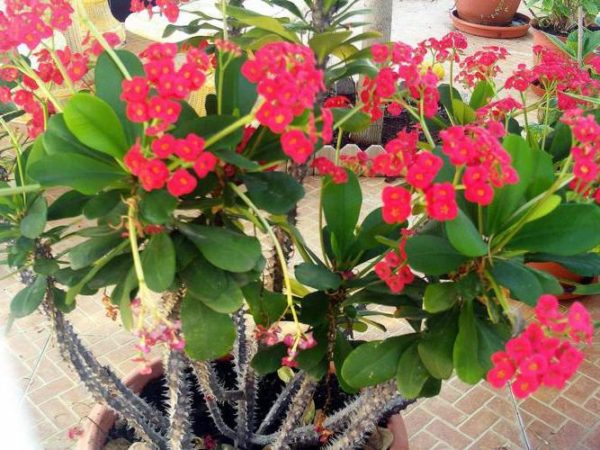

Shrub suitable for dividing
The divided parts of the bush should be planted in pots with a prepared drainage layer and special soil. This breeding method is not easy test for milkweed, so at first its development will not be intense.
Flowering in the first year unlikely... The plant will recover and begin to fully develop approximately after 2 years.
Euphorbia photo gallery
Photo
In the photo below, you can see what a plant called euphorbia looks like.
Euphorbia white-veined:
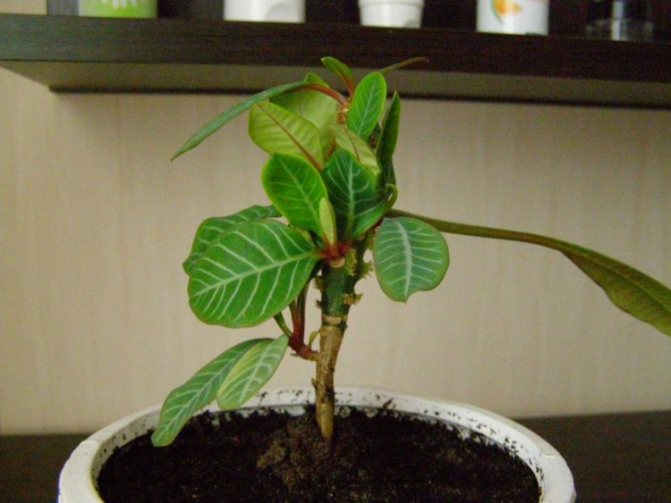

Euphorbia Mila:
Euphorbia obese:
Euphorbia triangular:
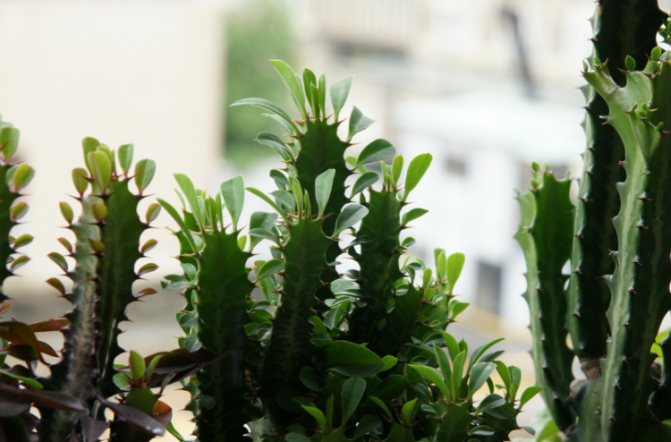

Euphorbia is strong:
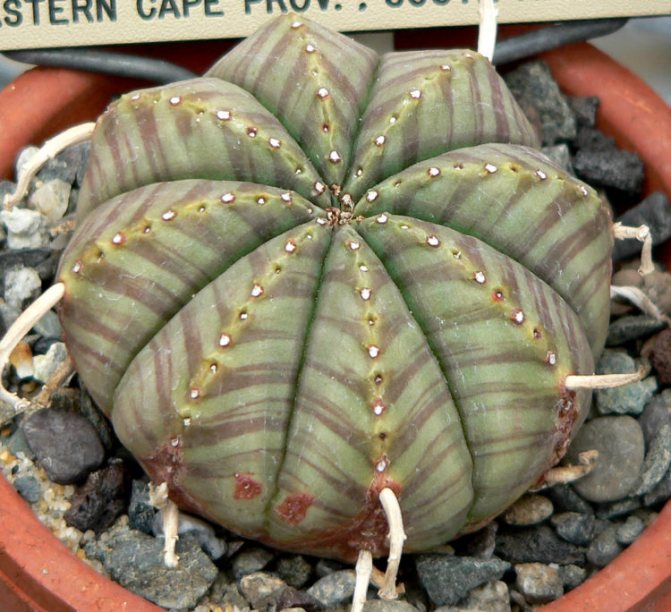

Types of milkweed
Euphorbia is grown indoors, in the garden as annuals or perennials. Euphorbia, suitable for outdoor cultivation, tolerate frost, drought, disease resistance and are rarely infested by pests. In places of natural growth, milkweed grows to large sizes, representing trees or semi-shrubs.
Euphorbia grown by flower growers can be divided into garden and indoor. Among the euphorbia growing in the open field, we list the most popular.
- Cypress. This plant is used in garden design. A composition of several plants looks compact. The erect stem is covered with narrow leaves. The top is crowned with small yellow flowers gathered in a group. It easily tolerates summer drought and frosty winters. Often considered a weed.
- Euphorbia. The plant got its name for the red upper leaves. And the bracts acquire a carmine shade by autumn. The spurge reaches a height of almost a meter.
- Bordered spurge (marginata). Many in their dachas, in private houses in the yard grows an annual unpretentious plant, which is popularly called "bride", "rich bride" for the white border on the leaves. But few people know that this plant is from the genus of milkweed. A white border forms during flowering. The flowers of the bordered milkweed are small, white, located at the tops of the shoots. It can grow both singly and as a small bush.
- Multicolor spurge. Grown in gardens as a shrub. From spring to frost, it pleases not only with a compact, rounded bush, but also with abundant flowering. The bush is literally covered with beautiful yellow flowers. The plant is perennial, tolerates frosty winters and dry summers well.
It might be interesting: Hoya - home care tips
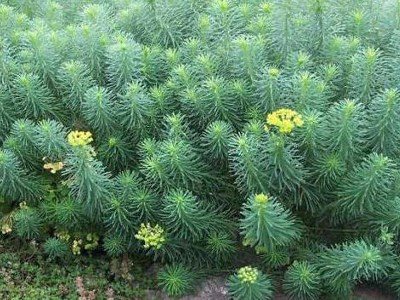

Cypress variegated
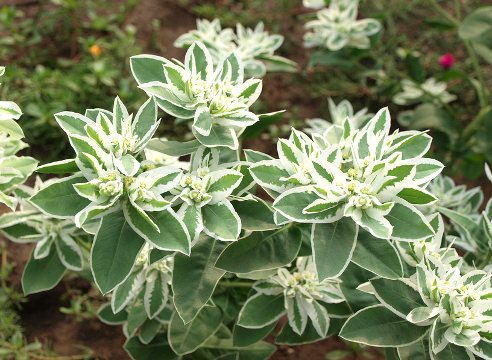

Bordered
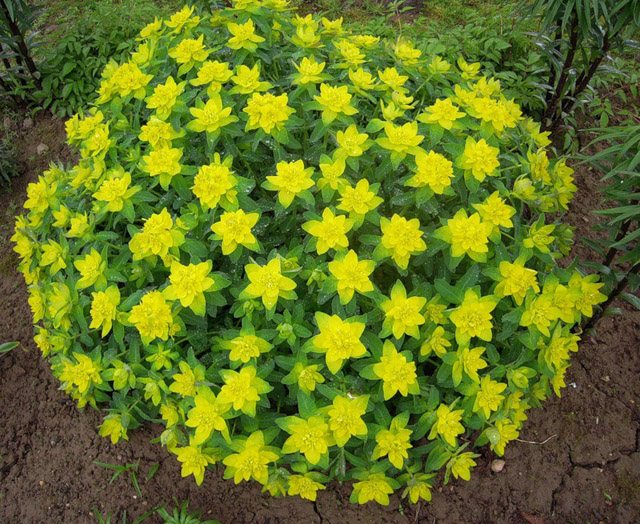

Multicolor
The second group of euphorbia is room euphorbia. Among them you can find plants with and without leaves. Many euphorbia are similar to cacti. Lovers of cacti are advised to pay attention to the following types of euphorbia:
- Thorn. In nature, it grows up to one meter high. When grown in an apartment, it is smaller. The ribbed stem resembles an echinocactus, but differs from it in the number of ribs, size and number of thorns.
- Bristled spurge. It has a straight stem with prominent ribs covered with sparse spines. Under natural conditions, it grows in the form of a tall shrub.
- Fatty (obese) euphorbia. Its shape is similar to a cactus. But, unlike him, it does not have thorns. The ribs of the milkweed are wide, slightly protruding. As it grows, the stem changes from a spherical shape to a cylindrical one. Usually indoors it reaches up to 12-15 centimeters in height and 10 centimeters in diameter.
- Melon spurge. It is very similar to obese euphorbia, but has the shape of a ball about ten centimeters in size. Low-protruding ribs are covered with small growths, similar to dry twigs. This type of milkweed is rarely found in apartments.
Thorn
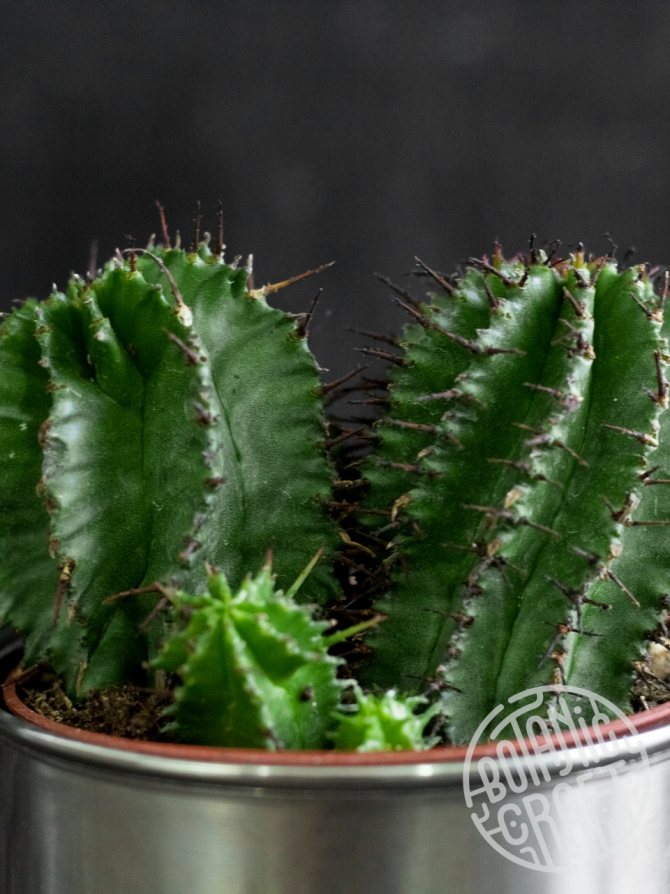

Bristled Bold
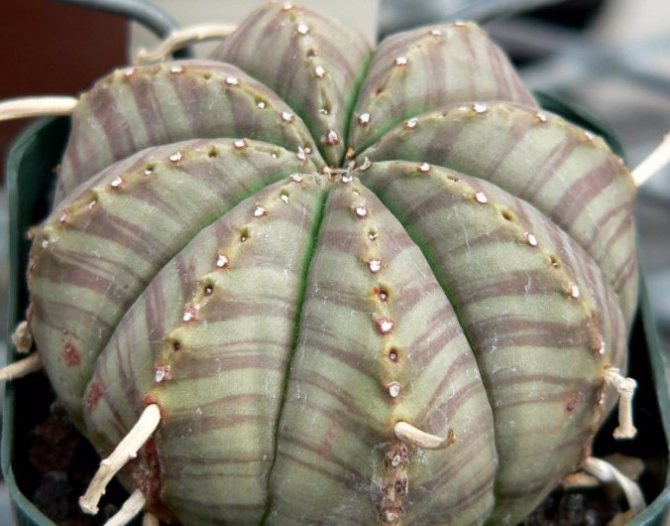

Melon-like
Now let's talk about milkweed with leaves. Among them, the first place is occupied by Euphorbia the most beautiful or familiar to many Poinsettia... Its second name is Christmas flower. You can read about how to care for Poinsettia in a separate article on our website. Its bloom coincides with Catholic Christmas. In fact, this species of milkweed has very small flowers. And the flower is decorated with red, pink or white top leaves. In its shape, the group of red leaves resembles a Christmas star. Unfortunately, poinsettia does not tolerate the dry air of apartments, and often dries up after flowering in indoor conditions. Therefore, many donate it for the New Year holidays, and throw it away after flowering.
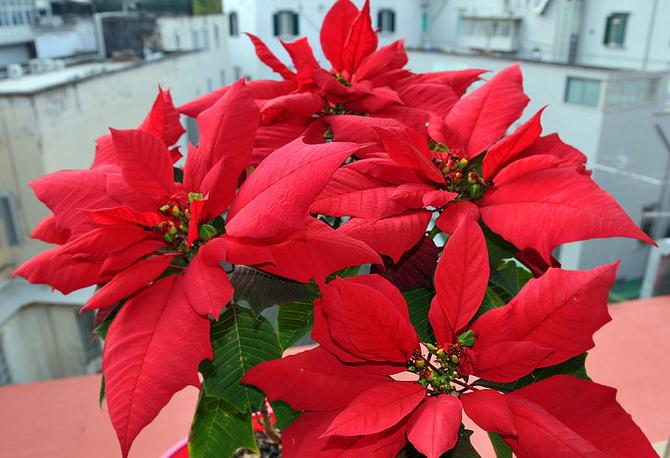

Poinsettia
Let's take the second place Akalife or foxtail. Grown as an ampelous plant. Hanging shoots, with semi-oval serrated leaves, are decorated with bright red flowers at the ends. The flowers are panicles that resemble a fox's tail.
Akalifa
Another ampelous plant of the genus Molochaevs is called "Diamond Frost". It is decorated with many white small flowers, through which light green elongated leaves peep out.
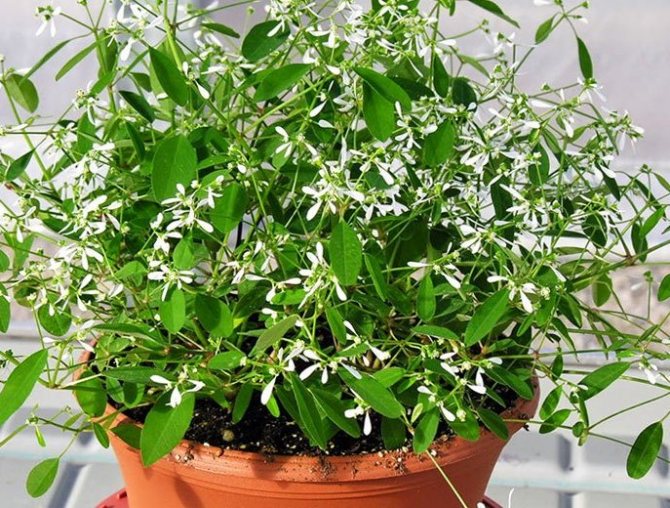

Diamond frost
One of the beautiful milkweed is called spurge Mil or "crown of thorns". Differs in unpretentiousness and beautiful flowers. In fact, the beauty of the plant is not given by small flowers, but by bright bracts of red or yellow color. Spiny gray shoots in the upper part end with dark green oblong leaves, rounded to the edge. Over time, Euphorbia Mila loses its decorative effect, because shoots without leaves make up the bulk of the bush.
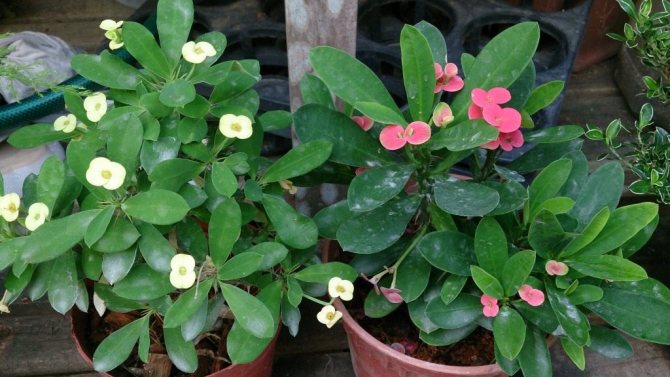

Mile
Ribbed spurge also has leaves only at the top. Long leaves, with white transverse veins, become wider towards the edge. It has one ribbed stem, which gives the plant a resemblance to a palm tree. It can grow up to a meter in height. Ribbed spurge blooms with pink or white flowers.
Ribbed
Belozhilkovy spurge is very similar to ribbed, but has several differences. Its trunk is smooth, not ribbed. White-veined blooms with small flowers. The leaves are more rounded with distinct white veins.
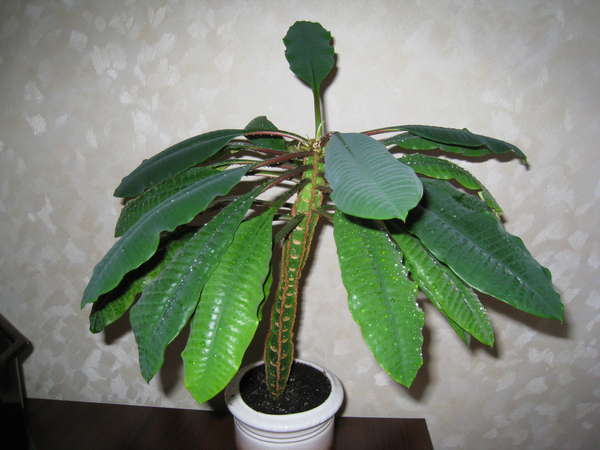

Belozhilkovy
Euphorbia trigone or triangular spurge has unusual stems. Bright green shoots of a triangular shape grow up to half a meter. They extend from the main trunk and extend upward. Small leaves grow at the edges of the faces. Slender long stems often break.
Trigona
Euphorbia tirucalli. It is used in the interior of apartments and offices and attracts attention with its unusual appearance. Its thin branching branches have neither leaves nor thorns. Indoors it reaches a height of three to four meters. Flowers are small, yellow.
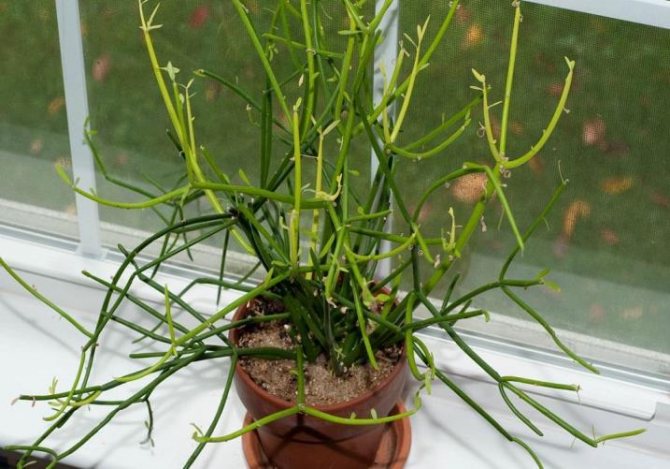

Tirucalli
Euphorbia is the head of a jellyfish. This type of euphorbia is often found on the windows of succulent lovers. The name reflects well its appearance. From a short stem, flexible shoots protrude in all directions. They are covered with small tubercles with tiny leaves. Flowers are small, yellow-green in color.
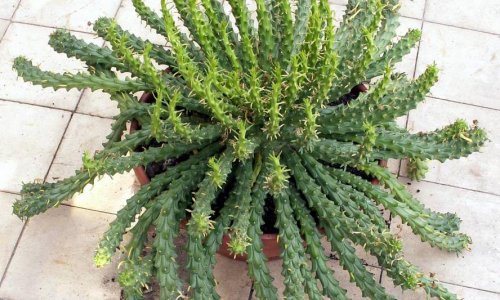

Jellyfish head
Large-horned spurge attracts with its unusual shape. Triangular stems are divided into pronounced segments, and the edges are dotted with gray or brown spines. Shoots branch out to form a bush. At the ends of young shoots, small leaves appear, which soon crumble. The large-horned spurge is popular with lovers of original plants.
Bighorn
Of course, it is impossible to tell about all the milkweed grown indoors. We have introduced you only the most popular species.
It may be interesting: Decembrist (Schlumberger) - description, types and varieties
Benefits and Applications
- Indoor spurge is a rather beautiful plant, so it is often used for decorative purposes.
- Euphorbia is a rubbery and tanning plant species (although this quality is not widely used in industry, but the natives used this property for their own needs).
- Milkweed juice, although poisonous, is used in small doses to treat certain types of diseases.
At home
- Euphorbia is unpretentious and hardy. Perfect for those housewives who forget to water their flowers.
- Euphorbia is used for landscaping offices, offices and other institutions. Due to the fact that all types of milkweed can grow quite quickly and up to 1-2 m, they fit perfectly into the office space.
- Euphorbia can also be grown in gardens.
In medicine
- The juice is used as a base for medicines.
- Milk juice has analgesic, anti-inflammatory and antipyretic properties.
Description
Among the milkweed, there are about two thousand species, which are so different from each other that few consider them to be relatives. In nature, euphorbia grow in the subtropics, found in Africa, on the island of Madagascar, in Central America.
Most euphorbia resemble a cactus, have a thickened stem. Leaves may be completely absent or small in size. This allows the plants to retain moisture.Euphorbia is distinguished by undemanding conditions of detention, endurance. She is not afraid of the dry air of apartments and rare watering. But this does not mean that they do not need regular, albeit infrequent, care.
Important! A distinctive feature of all milkweed is the presence of poisonous sap in the stem of the plant.
This white juice, similar to milk, gave the plants their second name - spurge. At the same time, in different types of euphorbia, the amount and degree of "toxicity" of the juice differ. The juice can irritate the skin. It is especially harmful to children, animals and people prone to allergies. Therefore, when growing euphorbia in an apartment, it is necessary to place it out of the reach of children and pets.
Since the types of euphorbia are very different from each other, their detailed description will be given in the "Species" section.
Feeding procedure
Euphorbia needs to be fed regularly as the plant grows. This is done every 2 weeks by adding special formulations for cacti and succulents. For flowering varieties, feeding for similar plants is more suitable, but the concentration should be reduced by 2 times in comparison with the dosage indicated in the instructions.
Milkweed species that are spherical or have thick stems should not be fertilized with nitrogen-containing formulations. An excess of this component will lead to cracking of the skin. Top dressing for orchids will be useful.
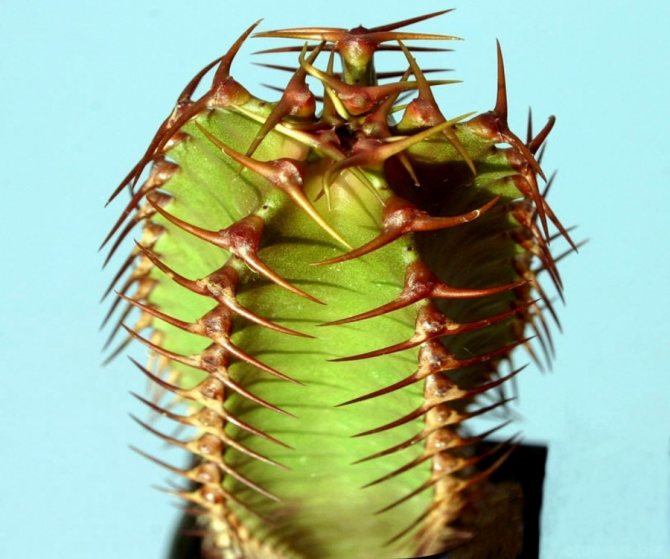

Priming
For normal growth, euphorbia needs planting in loose soil with the obligatory laying out of the drainage layer. For planting milkweed, you can use ready-made soil for succulents, or prepare it yourself.
Ready-made store mixes are dry, therefore recommended add low-lying peat to them.
For self-preparation of the soil, you will need to mix leafy earth, sand and humus in a ratio of 2: 3: 2. A mixture of sand and garden soil in equal proportions is also good.
For all the pros and cons of different soils for succulents, see the video:
How to care immediately after purchase?
Immediately after purchase, euphorbia should be transplanted into a more suitable pot and soil. From the store, the flower arrives in a container suitable for transportation, but not for life.
If the container is suitable for growing, then the substrate in it is special, with the addition of growth stimulants.
After transplanting into an optimal container with a nutrient mixture, you should take care of the flower as follows: transfer to a permanent place, provide bright diffused lighting, moisturize the soil, maintain an optimal temperature regime of + 21 ° C ... + 24 ° C.
Types and varieties of milkweed for growing at home
According to various sources, the genus of milkweed has 800-2000 species. Only a small number of them can only grow in the wild. Many species have been quite successfully cultivated as a house flower. The most common types of indoor milkweed are described below.
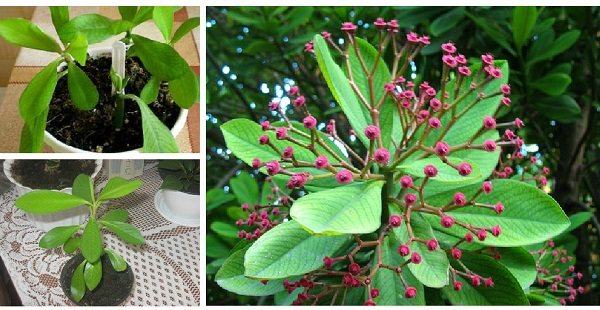

Bordered
Annual growing up to 0.7-0.8 m in height. Has erect stems. Leaves are oval up to 4 cm in length. During flowering, a white border appears along the edge of the leaves.
Belozhilkovy
Herbaceous perennial native to Madagascar. In nature, it grows up to 1.5 m. The root system is pivotal, grows deep into the ground. The young shoot is solitary, the older one is weakly branched. Below the stem is lignified, cylindrical. Upward, it becomes five-ribbed. The leaves are petiolar, obovate, arranged alternately in a spiral. Gradually, they die off and remain only at the top. Petioles are greenish-red. The front surface of the leaves is green with distinct whitish veins, from the inside they are pale green.
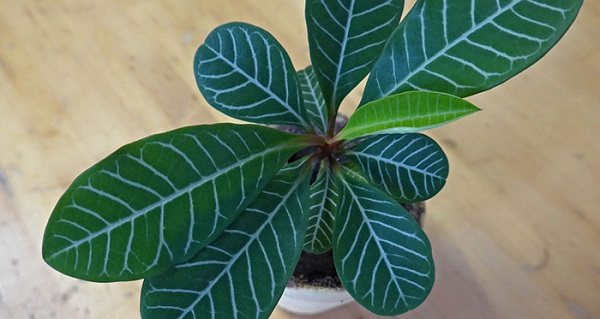

Trihedral
Branching succulent up to 2 m high, native to South-West Africa. The stems grow strictly vertically. The leaves are ribbed, with 3 flat edges. On their tops there are many reddish-brown spines that look like claws.In the axils of the thorns there are small fleshy leaves 3-5 cm long.
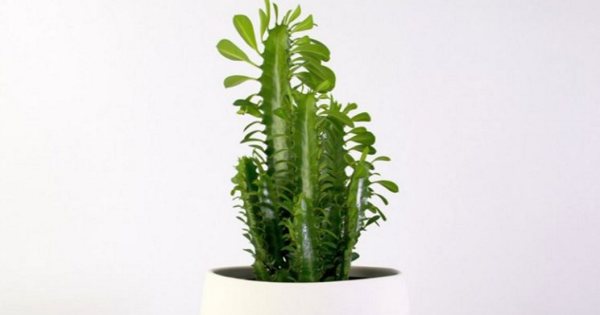

Comb
An evergreen succulent shrub native to Mexico. The stalk is thick, ribbed, outwardly similar to the white-veined milkweed. Leaves are elongated, oval, located on red-brown petioles at the top of the plant. The shade of the bracts is white-pink.
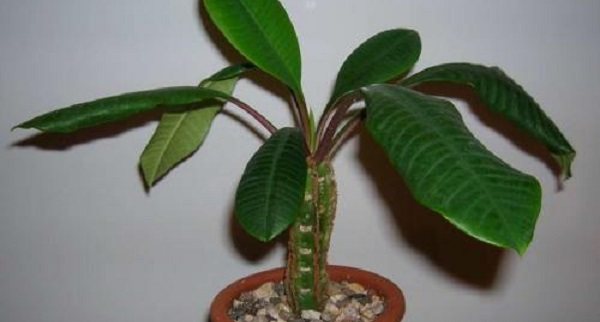

Mile
It is also called brilliant milkweed. It is a highly branching succulent native to Madagascar. The stem is tuberous, grayish. It has many thick conical needles up to 3 cm long. Leaves are elliptical or obovate, with short petioles. From below, they die off over time and remain only at the top. The color of the flowers can be different (white, yellow, pink, orange). Bracts have a large limb.
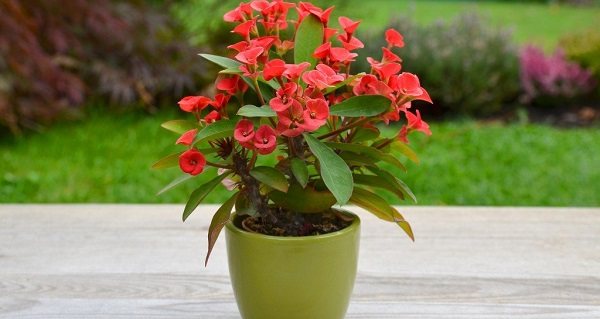

Prettiest or Poinsettia
One of the most beautiful species native to Central America. Poinsettia is a tall, highly branching shrub with slender, angular stems. Leaves are oval-pointed or lanceolate with jagged edges up to 16 cm long. Their surface is leathery-rough with embossed veins. The bracts are large and bright, resembling leaves in size and shape. The original form has red bracts.
Bloom
Flowering is characterized by the appearance of small inflorescences at the base of the leaf blades. Euphorbia begins to bloom in April. The flowering process stretches for the entire period of active development. In the winter season, in the presence of good lighting, flowers may also appear.
Annual flowering is not available for all types of euphorbia. For example, the flowering of the Large-Horned Milkweed or the Tirucalli Milkweed is very a rare event in a closed room. Euphorbia Mila and the most beautiful euphorbia bloom easily every year.
If it does not bloom, the reasons should be sought in insufficient sunlight or overfeeding the plant with fertilizers.
Blooming Euphorbia Mil
Flowering milkweed ribbed
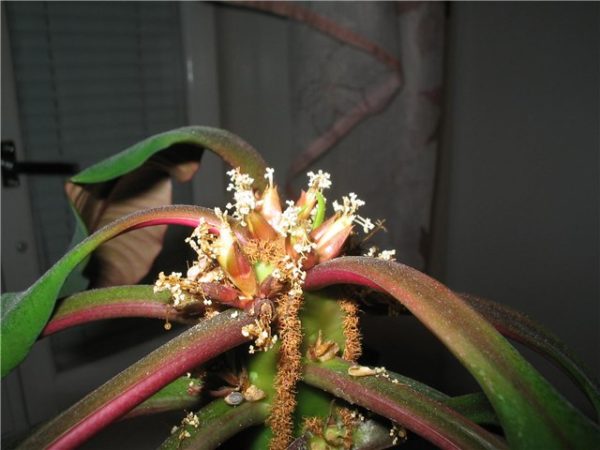

Flowering white-veined milkweed
Flowering plants take a strong place in the hearts and apartments of flower growers. Taking care of them is not always easy, but if you know the basic rules, you can achieve success. We have prepared for you a whole series of useful articles on this topic. Read everything about Balsam, Gerberas, Hortensia.
Pests and diseases of indoor milkweed, plant care and treatment
Improper care leads to diseases and loss of the decorative appearance of the bush. If the leaves fall or turn yellow, then there are signs of decay of the roots and stem, the reason may be hiding in temperature changes and draft, lack of nutrients or lighting, improper watering. Brown and black spots indicate fungal infection. To fight, the plant must be treated with fungicides.
Often this flower becomes a haven for pests. It is very easy to identify and control parasites:
- pale yellow and silvery stripes leave thrips. Round spots of brown, orange and white colors indicate the vital activity of the scale insect. They are fought with the help of phytoverm, aktara insecticides;
- mealybug leaves a white bloom on the shoots and leaves. The bugs must be collected by hand, and the bush must be treated with soapy water mixed with machine oil once a week. The bug also does not like infusions of calendula, tobacco, garlic;
- you can find the root worm during transplantation. The bugs are removed with hot water at a temperature of approximately + 50C. Fresh substrate after transplanting is watered with Actara once a week for a month;
- a spider mite on the back of the leaves leaves a whitish bloom. Areas where the pest appears are wiped with soapy water and alcohol;
- the presence of small black and green bugs indicates aphid infestation. Infusions of hogweed, mustard, capsicum, onion, garlic, alder can help get rid of it.
Photo gallery - euphorbia in the garden and at home
Features of the
The main property is the presence of white milky juice. The ancient Roman physician and botanist Euphorbus, the court physician of the Numidian king, studied the plant for many years, developed recipes for treatment. The spurge owes its second name to him.
Euphorbia has many beneficial properties:
- used in garden design;
- serves as a decoration for the home interior;
- used in cosmetology - freckles are whitened with cell juice, excess pigmentation is removed;
- used in folk medicine - a natural aphrodisiac, has many medicinal properties.

